Contents
- What is an enterprise backup solution?
- What is NOT an enterprise backup solution?
- 2025 objectives and challenges of enterprise backup solutions
- Why is business size important in choosing a backup solution?
- Choosing the correct enterprise-grade backup software solution
- Enterprise cloud backups
- Best enterprise backup solutions list
- Enterprise backup software comparison
- How to choose an enterprise backup solution?
- Who are the most frequent user of enterprise backup solutions?
- The future of enterprise backup and recovery
- The impact of enterprise backup solutions on environmental sustainability
- Conclusion
- Why you can trust us
- Frequently Asked Questions
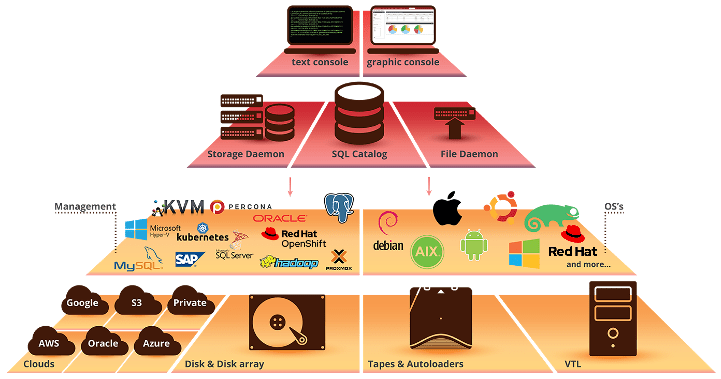
What is an enterprise backup solution?
An enterprise-grade backup solution includes both backup software itself and immutable storage of various types, network connections with high-rate bandwidth, and the company’s internal knowledgebase, training for new employees, and the vendor’s documentation: all vital elements of any backup system.
As more and more organizations increasingly depend on their IT infrastructure, enterprise backup software tools have become indispensable components of modern business operations. These solutions now play a pivotal role in transforming organizations and preserving their vital operations by safeguarding data from loss, from corruption, and from human error and theft.
The leading enterprise backup software solutions both support specific technical features and help to:
Reduce backup and recovery costs
The cost of data recovery when the data is stored in the cloud can be significant. Cloud storage providers tend to charge less for uploading data but much more when the data is downloaded for recovery purposes. Ideally, backup software should minimize the download volume in this particular case and, thereby, minimize disk and tape storage costs.
Simplify backup administration
Enterprise IT infrastructures with their tens of thousands of endpoints (computers, servers, VMs and others) can be complex to manage. Backup can be a nightmare for an admin who must think about: the backup’s destination, whether there is enough storage space available; network bandwidth; the retention policies for this data; and whether older copies must be migrated elsewhere to free up space. If your backup solution supports helpful efficiency tools, such as automated copy or migration of backed up data; automated restart of backup jobs after cancellation; job scheduling; and sequencing with priorities; all of which can help system administrators sleep better at night.
Minimize staff training and ongoing support
In addition, enterprise companies typically have large IT staffs. Teaching new employees on how to use the backup system can be extremely time-consuming. Leveraging intuitive UI and automation features can significantly reduce the need for extensive staff training and ongoing support, making the management of enterprise backup solutions more efficient and cost-effective.
Enhance regulatory compliance
The backup system should be able to adjust to changes in the organization’s regulatory mandate. Depending on the nature of the enterprise, compliance regulations could be generic, like GDPR, or industry-specific, like HIPAA, ITAR or CMMC 2.0. Local regulations can also apply here: examples include Australia’s Essential Eight, UK’s Government Security Classifications, and more. Enterprise companies operating worldwide must navigate a complex landscape of compliance regulations worldwide.
What is NOT an enterprise backup solution?
Solutions that try to appear, or even be, enterprise-grade may in fact not be truly enterprise-level, which poses an additional risk for customers seeking to replace an existing solution or establish a brand-new backup infrastructure. What follows is what might not be options for those with true enterprise-grade requirements:
- Backing data up to a public consumer cloud service such as Dropbox, Google Drive or Microsoft OneDrive. This is unlikely to be used in an enterprise-level scenario. These tools have synchronization features, but lack significant security, disaster recovery, and performance qualities for enterprise datasets. Instead, the better solution is to integrate with AWS, Azure, Google Cloud, Oracle Cloud and other private clouds through S3 interface.
- Consumer-grade backup solutions and solutions which were targeted towards the consumer market when they were initially released. Certainly, most backup companies try to target both consumer and enterprise markets initially and evolve their technology accordingly as their customer base evolves, but a solution that was initially designed for personal use is very difficult to modify for enterprise needs. Scalability and flexibility, which are necessary in enormous heterogeneous IT environments, can rarely be adequately achieved in such cases.
- Solutions that lack offsite storage backup options, such as tape media, should not be considered enterprise-ready. Relying solely on server disks, NAS, or SAN, is no longer enough: there must be an offsite air gapped location, like a tape or special cloud data center, which will deliver redundancy and DR to the system.
- Open source backup tools without enterprise support. Some open-source enterprise-grade backup tools have some technical features that can be used in demanding IT environments. However, open-source often lack professional support and reliability through SLAs, which increases the risk of both data loss and the inability to restore data. One notable exception is Bacula, which is open-source-based, but which provides full SLA’s to the highest levels for even the largest organizations.
A good enterprise backup solution should include features such as:
- Extensive data protection capabilities. Features such as backup immutability, backup data encryption, 3-2-1 rule support and granular access control lists are essential for protecting information from tampering. Enterprises across the world are constant targets of ransomware attacks of all kinds, so protection of the backed-up data should be the strongest available.
- Support for multiple backup policies and different backup levels. Different backup variations are suitable for specific use cases and situations. Full backups are slow but include all of the folders and files within the backed-up environment. Differential backups copy only files modified since the last full backup. Incremental backups cover only data modified since the previous backup, no matter the type. Enterprise-ready solutions frequently face large datasets, which is why the best of them provide the opportunity to create synthetic full backups: a new full backup which is limited to all incremental backups since the last full. Synthetic backups help to save storage space, network bandwidth and, importantly, budgets.
- Disaster recovery & business continuity. Minimal downtime and ensured business continuity are critical to all enterprises, so backup solutions for enterprises must be able to offer automated failover for business-critical systems and to support high availability infrastructures. Data replication to offsite storage, like tape, is also necessary for resilience. A very important aspect of any successful DR is bare metal backup and recovery, which should to be supported in both Windows and Linux environments.
- Support for various storage media types. Most enterprises operate sophisticated systems that include multiple storage types with complex infrastructures. Any enterprise backup solution must support different storage media types, be it on-premises servers, virtual machine disks, enterprise cloud storage (both public and private), or magnetic tape. With the rise of the 3-2-1 rule, air-gapping, and other security measures, it goes against best practices for an enterprise-grade backup to support only disk storage and be unable to backup to tape, for example.
- Flexible data retention options. The ability to implement both long-term and short-term data retention policies is a significant advantage in this market, because enterprises and large corporations must comply with various regulatory requirements (including the necessary time for which data must be retained) applicable to the different types of data they own. A good backup solution should offer flexible retention controls and support custom deletion protocols and automated pruning jobs.
This list is far from comprehensive. Necessary enterprise-grade backup features are explored later in the article.
2025 objectives and challenges of enterprise backup solutions
In 2024, the importance of data security is at an all-time high, with geopolitical conflicts and cyberattacks occurring regularly. Ongoing hacking campaigns for example, gain more momentum as time goes on, and the number of cyber-attacks continues to grow in both strength and complexity.
In this context, no security feature can be considered excessive, and some of the most sophisticated options have become far more common and widely used than ever. For example, air-gapping as a concept works well against most forms of ransomware, because it physically disconnects one or more backups from the outside world.
Similar logic applies to backup immutability: the ability to create data that cannot be modified in any way once it has been written the first time. WORM (write-once-read-many) storage works well at creating immutable backups and many enterprise backup solutions also offer such capabilities in one way or another.
Data security and resilience remain top priorities for enterprises in 2025, driven by evolving threats, rapid technological advancements, and the ever-increasing number of regulatory demands. While many challenges from previous years persist, newer trends have begun to reshape the objectives of backup strategies in large businesses and enterprises. Here are some of the most recent issues with which enterprise-grade backup software must contend:
- Improved ransomware resilience, because ransomware attacks continue to grow in scale and complexity. Features such as air-gapped storage, backup immutability, and advanced recovery orchestration have become the norm for many organizations, despite being nothing but helpful suggestions just a few years ago. There is also great emphasis on using AI-assisted anomaly detection to identify threats in real-time for better responses to each issue.
- Expanded integration of AI and ML, which have already transformed backup operations to a certain degree. Now these technologies may, if implemented carefully and sensibly, optimize backup schedules, predict system failures, and improve data deduplication capabilities of the environment. Additionally, AI-driven insights can also help companies with streamlining resource allocation, reducing operational overhead, and prioritizing critical data when necessary.
- Ongoing adaptation to both hybrid and multi-cloud environments, necessitating using backup software that is much more complex yet, at the same time, more versatile. There is great demand for cloud-agnostic solutions with centralized management, data encryption, and information portability as primary features.
- Improved emphasis on Continuous Data Protection instead of traditional backup windows, motivated by the need to maintain near-real-time data protection, while also reducing RTOs and ensuring business continuity. Both of these requirements make traditional backup windows much less relevant than ever before.
- Continuous evolution of regulatory compliance requirements, resulting in many new data protection laws and updates to existing frameworks. 2025 is guaranteed to both continue the demand to support all kinds of existing regulations and facilitate the introduction of newer ones that revolve around AI-related governance.
- Quantum computing continues to develop, with more and more emphasis being put on the introduction of quantum-resistant encryption algorithms, used by large enterprises to future-proof their data protection strategies. There are no signs that the development of quantum computing will slow, much less stop, in 2025.
- Improved support for containerized and microservice architectures is already extremely common and is expected to become the de facto baseline in 2025, with support for Kubernetes, Docker, and microservices becoming more and more common. Enterprises now need backup solutions that can manage not only multi-cluster environments, but also hybrid deployments, while also providing advanced recovery options with containerized workflows in mind.
- Sustainable and green initiatives are expected to continue increasing in relevance, as environmental sustainability is now a strategic objective for most companies. The prioritization of energy-efficient data centers and optimized storage usage with eco-friendly hardware in existing backup infrastructures will continue to support broader ESG goals as time goes on.
- Cost and value optimizations now go hand-in-hand, with cost controls retaining their importance and value optimization gaining the spotlight now and throughout 2025. All businesses now try to find the balance between security, scalability, resilience, and cost-efficiency on the one hand, and flexible licensing, advanced deduplication, and intelligent tiered storage on the other.
- The increasing concern for data sovereignty will continue to emphasize navigating cross-border data transfer regulations in 2025. Backup solutions now must support localized storage options with robust data residency controls and complete compliance with relevant international standards.
Why is business size important in choosing a backup solution?
Data backup challenges are specific to the size of the business. Small and medium-sized businesses (SMBs) are more likely to encounter sudden influxes of data that exceed their current management capabilities. Even though SMBs may not utilize multiple data storage mediums, the sheer volume of data they collect can still pose significant challenges. SMBs should prioritize cloud backup solutions that offer exceptional scalability, especially if they are experiencing rapid growth. Also, cloud backup solutions for SMBs should be easier to manage because they don’t require significant IT support and are much easier to deploy.
On the other hand, large and geographically dispersed teams often face challenges with managing incredibly large amounts of data that may be stored in multiple locations, causing great inconvenience in retrieving all this data in a structured manner. Larger organizations also tend store significant data separately from the rest of the information in the infrastructure, posing significant challenges in business continuity and data recoverability. The reliance of large enterprises on a diverse range of applications, DBs, virtualization and container technologies in the IT environment makes data backups particularly complex. Storage types can also include multiple cloud locations, tape, NAS devices and disks. Large enterprises should prioritize enterprise backup solutions that can effectively manage data in hybrid and complex IT environments.
Choosing the correct enterprise-grade backup software solution
When defining best solutions for enterprise backup, the following criteria should be considered by the typical enterprise company organizing and processing an increasing volume of information (petabytes of data) in a large data center with thousands of servers.
Since even the average level of requirements for an enterprise-grade backup solution is high, it would be easier to divide these characteristics into multiple thematic groups. This list divides these characteristics into three categories: Performance, Versatility, and Accessibility.
Performance
An enterprise backup software solution should:
- Be reliable and guarantee the integral and consistent execution of backup and recovery operations without loss or omission of data. Fault tolerance should be ensured using data integrity checks, corruption detection, verification of backups, and granular file-level recovery.
- Provide options for maintaining several concurrent instances of backup and recovery. These elements should be automated, so that both backups and recovery are carried out efficiently and with minimum execution time, without affecting the consistency of data.
- Provide tools that optimize the data volume transmission during the backups to save both storage capacity and network bandwidth on an enterprise-grade scale. This is done using both hardware and software capabilities: snapshots, 2-side deduplication, comm-line compression, and other methods.
- Provide the strongest encryption of the backed up data (AES 128, AES192, AES256 or blowfish as well as EFS for Windows) to guarantee its privacy and guarantee TSL (SSL) communication among backup system components. Storage daemons should also be encrypted.
- Support HPC, complex and big data IT infrastructures, which deal with petabytes of data and millions of files, and ensure sufficient performance in HPC environments (Hadoop, SAP HANA, Oracle, IBM HPSS and others).
Versatility
- Be capable of adapting to heterogeneous environments, since in many enterprise-level organizations it is common to use software and hardware of different types, characteristics and manufacturers, including servers, NAS devices, tape drives, operating systems, virtualization systems, applications, and databases.
- Be able to grow and adapt to rising data volumes and data retention requirements. This growth should not be impeded by a backup solution that becomes too expensive as it scales up, or by the increase in the cost of storage media.
- Facilitate the implementation of enterprise-specific backup tasks necessary to perform effective data backup strategies. These can include: condition- and event-based backup stopping and starting services; creating and deleting files; replication and migration of data; validating the execution of a backup job; generating alerts when job is not completed successfully; backup scheduling; and others.
- Allow the configuration of different levels of backup that efficiently conform to an organization’s backup policies, in terms of proper RTO (Recovery Time Objective) and RPO (Recovery Point Objective). Enterprise-grade organizations typically require full, incremental, differential, and virtual full (synthetic) backup levels.
- Support a wide range of virtualization systems, including VMware, Hyper V, Citrix Xen, Red Hat Virtualization, Azure VM, KVM, Nutanix, OpenStack and Proxmox. Many of these hypervisors can be used in a single enterprise-level organization in a single data center. It’s important to be able to both backup the full VM images and to be able to restore single files from them, which can affect restoration speeds on an enterprise level.
- Support a substantial range of databases, including MS SQL, MySQL, PostgreSQL, MariaDB, Oracle, SAP HANA and Sybase. With enterprise-grade DBMS systems, it is important to ensure the ability to backup databases incrementally with PITR (point-in-time recovery) features.
- Offer tools to manage backed up data in various cases, such as:
- Complying with IT legal compliance regulations;
- Complying with quality standards, such as ISO;
- Complying with methodologies such as ITIL.
- Support data backup in hybrid cloud environments to allow the implementation of a high availability environment with adequate levels of redundancy. Cloud storage can be used as a media itself or as an endpoint. Cloud connectivity should include Amazon S3, Azure, Google Cloud, Oracle Cloud and Glacier at a minimum.
- Be FIPS 140-3 compliant and provide advanced security controls, including CRAM-MD5 authentication between components, various immutability features, SIEM integration, silent data corruption detection, and automated malware detection.
- Support container-based infrastructures that use Docker, OpenShift or Kubernetes, and be capable of backing up Docker volumes and Kubernetes clusters. These technologies are most likely to be used to build enterprise-grade container environments.
- Be capable of performing bare metal recovery for both Windows and Linux, as a part of the organization’s disaster recovery strategy.
Accessibility
- Integrate with enterprise monitoring systems and send notifications of backup operation processes. Additionally, notifications can be set up through emails or as push notifications on mobile devices, web browsers, etc.
- Allow interrelation with enterprise BI tools that can provide statistics on backups and, in this way, generate reports and dashboards that companies can use for diverse activities, such as storage capacity planning, bandwidth state, system functional indicators, and more.
- Allow backup and recovery administration to be multi-channel, but complete. To do this, the application must include utilities or tools that are cross-platform, easy to use, offer functionality to users with various levels of expertise in configuration, administration, and monitoring of backups.
- Allow the organization to manage the storage resources in which the backed up data is stored. In enterprise-level companies, this may include disks, tape drives, auto-changers, cloud storage devices, NAS or SAN devices, or online storage applications.
- Allow integration with mobile devices, phones or tablets, including notifications and administration and monitoring capabilities.
All these characteristics contribute to protecting the company’s enterprise-grade IT infrastructure, including operating systems, servers, user data and applications, to avoid potentially catastrophic data losses that may put the company’s ability to continue in business at risk. Knowing what to look for makes it much easier to determine which solution is the best possible option for your specific company.
Enterprise cloud backups
Before providing a sample list of available backup software, there is one more important topic to be discussed: cloud backups – a relatively common element of enterprise-grade backup solutions that offer cloud storage as one of several storage locations for enterprise backups.
Large-scale enterprise backup software often offers cloud storage capabilities in some way. As such, there is a list of factors that potential clients should keep in mind when it comes to enterprise backup software with cloud capabilities:
- Understanding your expectations from a cloud backup is one good starting point, since a lot of enterprise-grade companies must find software that meets their specific RPO or RTO requirements. That way, the company can also clearly understand which of these two parameters is preferable, while learning which features are likely to be critical to them in this context.
- Performing bandwidth capability assessment is another good starting point, since cloud storage transfers the entirety of a company’s information using a network connection. Ensuring that a cloud service’s backup constraints will not affect the company’s regular operations is a necessity. There are some specific cloud backup storage features that can reduce the potential network load, such as support for continuous incremental backups.
- Evaluating the capabilities of customer support is entirely logical in the context of the long-term relationships in which most enterprise cloud storage solutions work. Every issue with cloud storage that cannot be resolved in a timely manner can be a significant detriment to an enterprise’s data recovery process, and potentially to its business. Competent customer support directly contributes to solving these issues in most cases.
- Learning about the reporting and alerting capabilities of the cloud storage solution is another necessary step in the process of evaluating these systems. One of the primary goals of these systems is to keep track of a company’s data stored in cloud storage. Receiving regular updates on the current data state from a cloud storage provider is a great way to make the overall workload of administrators a little easier.
Enterprise-grade cloud storage can be a great addition to any existing backup system or infrastructure, especially in the context of the well-known “3-2-1 rule”. This rule implies three different backup copies, stored using at least two different device types, with at least one copy stored in a geographically different location from the rest. The last part of this rule can be a good use of cloud storage.
The remote location in this case can be physical storage that is geographically separate from the current location, or cloud storage that does not have a dedicated storage location.
Best enterprise backup solutions list
Rubrik
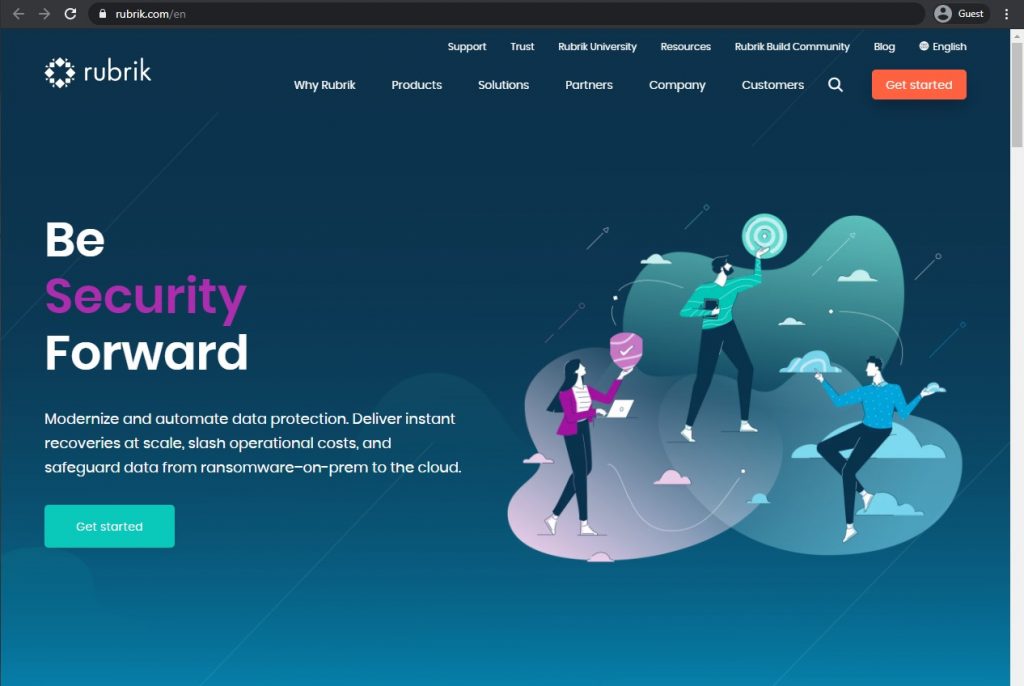
Rubrik is a well-known backup and recovery vendor on the market, specializing in hybrid IT environments. Rubrik Cloud Data Management (RCDM) is a proprietary product that makes data protection and cloud integration much easier. Of course, Rubrik also has its own data management platform, called Polaris. Polaris consists of Polaris GPS for policy management and reporting, and Polaris Radar for ransomware detection and rehabilitation as its main function.
Customer ratings:
- Capterra – 4.8/5 stars based on 74 customer reviews
- TrustRadius – 7.8/10 stars based on 234 customer reviews
- G2 – 4.6/5 stars based on 94 customer reviews
Advantages:
- Clean and organized administrative interface
- Multi-cloud and hybrid offerings and integrations with multiple cloud storage providers
- Vast automation capabilities
Shortcomings:
- Cannot backup Azure SQL directly to the cloud; requires extra steps to do so
- First-time setup can be long and difficult.
- Could use more documentation such as helpful articles and whitepapers.
- No on-premises backup realistically possible
Pricing:
- Rubrik’s pricing information is not publicly available on its official website. The only way to obtain pricing information is by contacting the company directly for a personalized demo or a guided tour.
- The unofficial information states that Rubrik offers several different hardware appliances, such as:
- Rubrik R334 Node – from $100,000 for a 3-node with 8-Core Intel processes, 36 TB of storage, etc.
- Rubrik R344 Node – from $200,000 for a 4-node with similar parameters to R334, 48 TB of storage, etc.
- Rubrik R500 Series Node – from $115,000 for a 4-node with Intel 8-Core processors, 8×16 DIMM memory, etc.
Customer reviews (original spelling):
- Jon H. – Capterra – “Rubrik has allowed us to stop focusing on the minutiae of running a homegrown backup storage/orchestration product and focus on automation of the infrastructure/deployment instead Rubrik has improved the performance of our backup jobs, allowing us to perform more backups with fewer resources overall Rubrik has given our clients more choice in how backups function.’
- Verified Reviewer – Capterra – “It’s improved operational efficiency, as we now don’t have to spend time scheduling backups, and has created very tangible savings. In the next 5 years we expect to save over 55% switching from our legacy provider to Rubrik. It’s also mitigated us against any future data centre blackouts through its Azure replication capabilities – while significantly reducing our power consumption and footprint in the data centre.”
My personal opinion on Rubrik:
Rubrik is a reasonably versatile enterprise backup solution that includes many features one might expect from a modern backup solution of this scale. It can offer extensive backup and recovery options, a versatile data management platform, a host of data protection measures for different circumstances, extensive policy-based management, and so on. Rubrik’s main specialization is in working with hybrid IT environments, but it can also work with practically any company,if the customer in question is fine with the price Rubrik charges for its services.
Unitrends
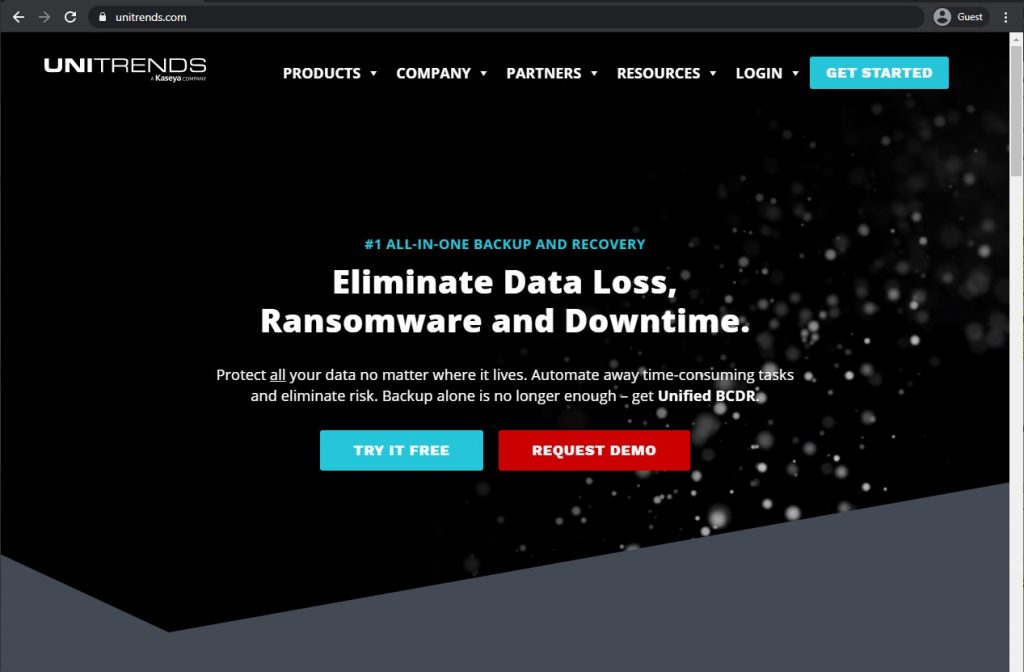
When it comes to Hyper-V and VMware backup solutions, Unitrends is always an option. First, it’s free for the first 1 TB of data and there are multiple editions (free, essentials, standard, enterprise, and enterprise plus) for customers with different needs and different data limits. Other features of Unitrends’ backup solution include instant VM recovery, data compression capabilities, ransomware detection service, protection for virtual and physical files, and, of course, community support.
Customer ratings:
- Capterra –4.7/5 stars based on 35 customer reviews
- TrustRadius – 8.0/10 stars based on 635 customer reviews
- G2 – 4.2/5 stars based on 431 customer reviews
Advantages:
- The backup process is easy to initiate once it is set up properly;
- Granular control over the entire backup process;
- Convenient dashboard with centralized access to a wealth of information.
Shortcomings:
- Single file recovery is not easy to initiate in the web interface;
- Infrequent false alerts;
- There are no instruction sets in the interface itself, only in web forums.
Pricing:
- Unitrends’s pricing information is not publicly available on its official website. The only way to obtain such information is by contacting the company directly for a quote, a free trial, or a guided demo.
- The unofficial information states that Unitrends has a paid version that starts at $349 USD.
Customer reviews (original spelling):
- Yuri M. – Capterra – “it give us less time to restore in case of the emergency and also the learning curve is quick. The reports are also very informative so we can know exactly what is happening with the backups and make sure we can restore in case we needed.”
- Richard S. – Capterra – “Support has been really good. But they suggested and did a firmware and software upgrade. I had to remove the client from all my servers and reinstall it. Then the backups didn’t run for several days. Have to work with support to get everything working again correctly.”
My personal opinion on Unitrends:
Unitrends emphasizes “solving the issue of complex backup solutions” in its marketing; the software itself is fairly competent. Unitrends’ chief offering is a backup and recovery platform that can cover virtual environments, physical storage, apps, cloud storage, and even endpoints. The ability to offer a centralized approach to managing a multitude of data sources at once greatly boosts the overall convenience of using such a solution, and most of its processes are highly customizable. It has its own issues, however, including a confusing pricing model and a problematic granular restore process, but none of these issues detract from the effectiveness of the software as a whole.
Veeam Backup & Replication
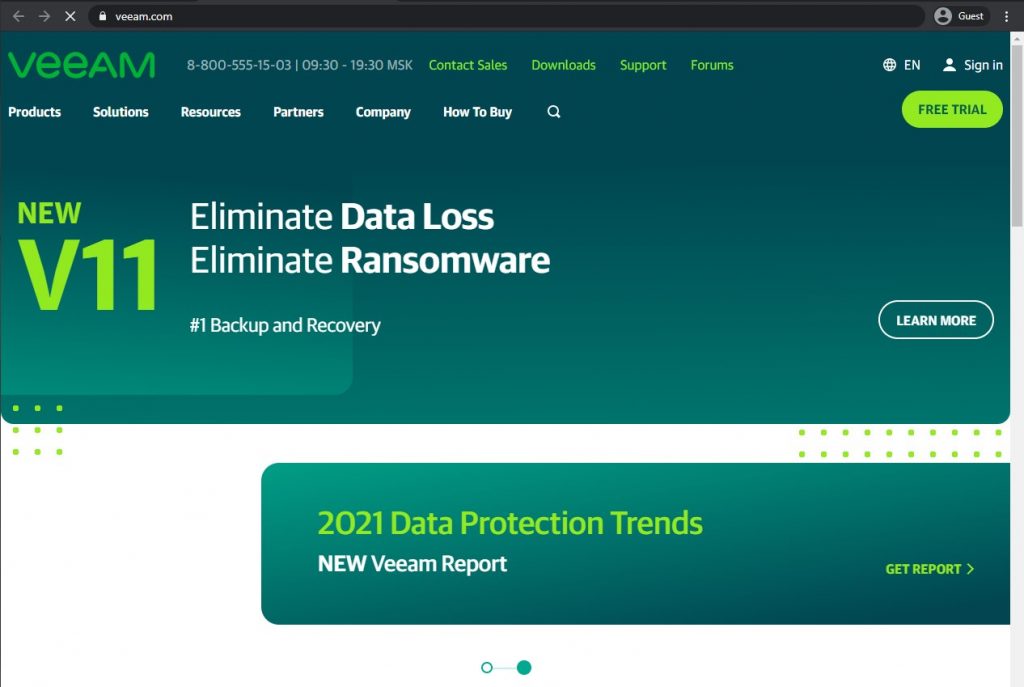
In virtual environments, then Veeam might be a first pick, with its cutting-edge technologies that allow flexible and fast data recovery when needed. Its all-in-one solution is capable of both protecting VMware vSphere/Hyper-V virtual environments and doing basic backup and recovery jobs, as well. The scalability of the solution is quite impressive, too, as well as the number of its specific features, like deduplication, instant file-level recovery, and so on. Veeam’s distribution model is not exactly complex, either: there are several versions with different capabilities and variable pricing.
Customer ratings:
- Capterra – 4.8/5 stars based on 75 customer reviews
- TrustRadius – 8.9/10 stars based on 1,605 customer reviews
- G2 – 4.6/5 stars based on 634 customer reviews
Advantages:
- Initial setup is simple and easy;
- Most of Veeam’s solutions are available for free for smaller companies with some limitations;
- Outstanding customer support.
Shortcomings:
- UI could be more user friendly
- The pricing of the solution is higher than average
- Learning the entirety of Veeam’s capabilities requires significant time and resources
- Security levels can be questionable
- Only protects a limited range of virtual machine-types
Pricing:
- Veeam’s pricing information is not publicly available on its official website.The only way to obtain such information is by contacting the company directly for a quote or for a free trial. What Veeam does offer is a pricing calculator page that lets users specify the number of different environments to be covered with Veeam’s solution, as well as the planned subscription period. All of that can be sent to Veeam for a personalized quote.
Customer reviews (original spelling):
- Rahul J. – Capterra – “I am using Veeam since from February 2021. It’s actually a best software but faced many times backup issue when Server size were more than 1TB. Otherwise restoration process are good, Instance recovery process are also simple and useful for migration also.it’s seriously very good software for full server type backup (Host base backup).”
- Joshua H. – Capterra – “I use this to manage backups of office-facing and production servers in a non-profit business. We have less than 10 servers to care for and the free Community Edition is perfect. I have found the features and reporting to be robust. Practicing restores is no trouble. I have never needed vendor support to operate or configure this Veeam Backup & Replication – it works well and has good documentation!”
My personal opinion on Veeam:
Veeam may be the most well-known backup solution on this list; at least, it is one of the most popular.. It may focus on its VM-related backup capabilities, but the solution itself is also suitable for working to some extent in other environments: physical, cloud, applications, and more. It is a fast and scalable solution that has plenty to offer to practically every possible client type, from small startups and companies to massive enterprises. At the same time, it can be quite tricky to master all of its capabilities; security levels may be questionable;and its price is well above the market average.
Bacula Enterprise
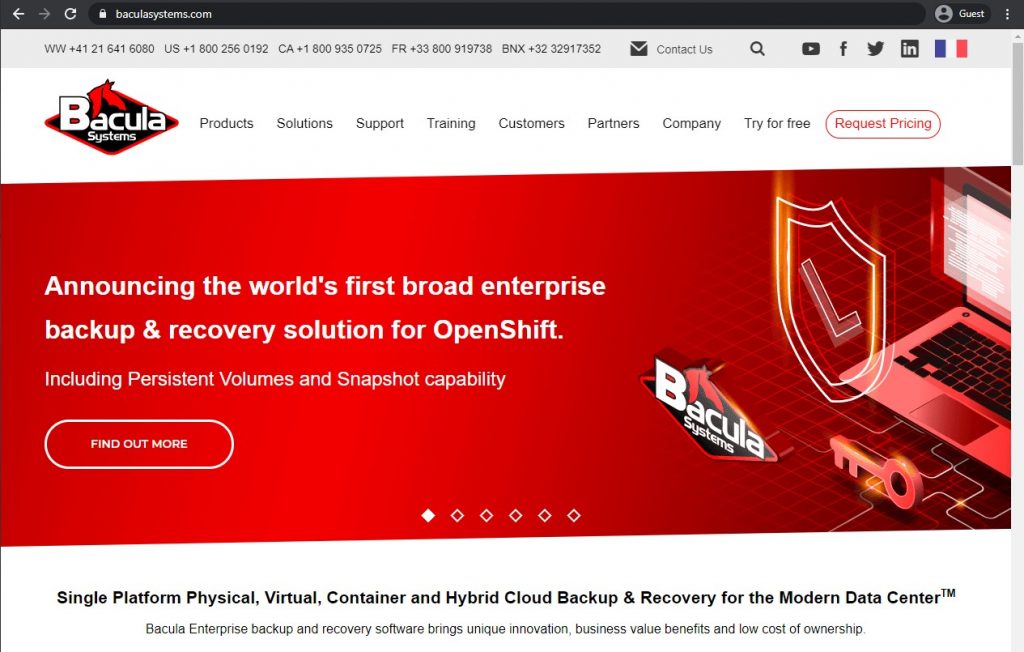
Bacula Enterprise is a highly reliable backup and recovery software that includes various functions, such as data backup, recovery, data protection, disaster recovery capabilities and more. It offers exceptionally high security and is best suited to medium enterprises and larger. Bacula provides an unusually large range of different features, from various storage types and easy setup to low deployment costs and extra-fast data recovery times. It can work with practically any (well over 34) Linux distributions (Debian, Ubuntu, etc.), and many other operating systems, too, including Microsoft, MacOS X, Solaris, and more. Bacula’s unique modular architecture provides even greater protection against ransomware and other attacks. It offers a choice (or combination) of both command-line and Web-based GUI’s. Its strong range of security features and many additional high performance, enterprise-grade technologies, such as advanced deduplication, compression, and additional backup levels make it a favorite among HPC and mission-critical, demanding enterprises. The licensing model does not charge per data volume, making it especially attractive to MSPs, ISVs, Telcos, Military and Research establishments, large data centers, and governmental organizations.
Customer ratings:
- TrustRadius – 9.7/10 stars based on 63 customer reviews
- G2 – 4.7/5 stars based on 56 customer reviews
Advantages:
- Especially high security levels and deployment flexibility;
- Job scheduling is incredibly useful for many reasons;
- Creates an effective backup and disaster recovery framework;
- Support for many different data environments, such as servers, databases, VMs, Cloud interfaces, in-cloud apps, etc.; and
- Users pay only for the technology they use, creating even more savings.
- Extreme scalability
- Single pane of glass coverage for diverse IT environments
- Storage-agnostic
Shortcomings:
- Web interface’s broad functionality requires time to learn;
- Initial setup process takes some time;
- Plugins that are not in the basic solution package come at an additional cost.
Pricing:
- Bacula Enterprise’s pricing information is not publicly available on its official website. The only way to obtain such information is by contacting the company directly for a quote.
- Bacula Enterprise offers many different subscription plans, even though there is no public pricing available for any of them:
- BSBE – Bacula Small Business Edition can cover no more than 20 agents and 2 contracts, offering features such as web support and BWeb management suite;
- Standard – can cover up to 50 agents and 2 contracts, adds support answer deadlines (from 1 to 4 business days);
- Bronze – can cover up to 200 agents and 2 contracts, offers phone support and shorter deadlines for customer support (from 6 hours to 4 days);
- Silver – can cover up to 500 agents and 3 contracts, introduces a deduplication plugin and a lower customer support answer deadline (from 4 hours to 2 days);
- Gold – can cover up to 2000 agents and 5 contracts, drastically reduces customer support answer deadline (from 1 hour to 2 days);
- Platinum – can cover up to 5000 agents and 5 contracts, has PostgreSQL catalog support and one training seat per year for Administrator courses.
- Unofficially, Bacula Enterprise’s pricing starts at $500 per month.
Customer reviews (original spelling):
- Jefferson Lessa – TrustRadius – “During these two years, we have been using Bacula Enterprise as a backup and disaster recovery solution for our entire data environment. This tool solved the problems we had in monitoring backups and in the agility to recover information. We are currently using this solution for more than 2Tb of data in a primarily virtualized environment. Bacula Enterprise’s technical support has perfectly met all the needs we’ve had in recent years. The installation of the tool was easy and the entire team adapted well to the daily use of this solution.”
- Eloi Cunha – TrustRadius – “Currently, the Brazilian Naval Supply System Command uses Bacula Enterprise to backup and restore the database. As a result, we have advanced features and the ability to handle the high volume of data we need for daily life, performing snapshots, advanced deduplication, single-file restores efficiently and reliably. I can detail as pros & cons the following personal use cases. Reliability and great cost-benefit.
- Davilson Aguiar – TrustRadius – “Here at Prodap, we have been struggling for a long time to access a Backup software that was good and cheap, we found Bacula as the best value for money. Right from the start, it solved our compression problem because the others we used weren’t very efficient about it. It made us take up less storage.”
My personal opinion on Bacula Enterprise:
I may be a bit biased, but I believe that Bacula Enterprise is one of the best possible options on the backup and recovery market for large companies and enterprises. It is a versatile backup solution with a proverbial ocean of features and capabilities. At the same time, many features that are not part of Bacula’s original package can be added to it via a system of modules that extend its functionality in some way. Bacula offers modular architecture, supports over 33 different operating systems, and has impressive range in supporting specific storage types and data formats. Above all, Bacula’s superior levels of security and its ability to mold those security layers to an organization’s (often very) specific needs cannot be overstated in today’s world of geo-political tension, aggressive ransomware and other security attacks. It can take time to learn initially, and users need at least a little Linux knowledge, but the wealth of features available to even an average Bacula user is more than worth the effort it takes to learn it.
Acronis Cyber Backup
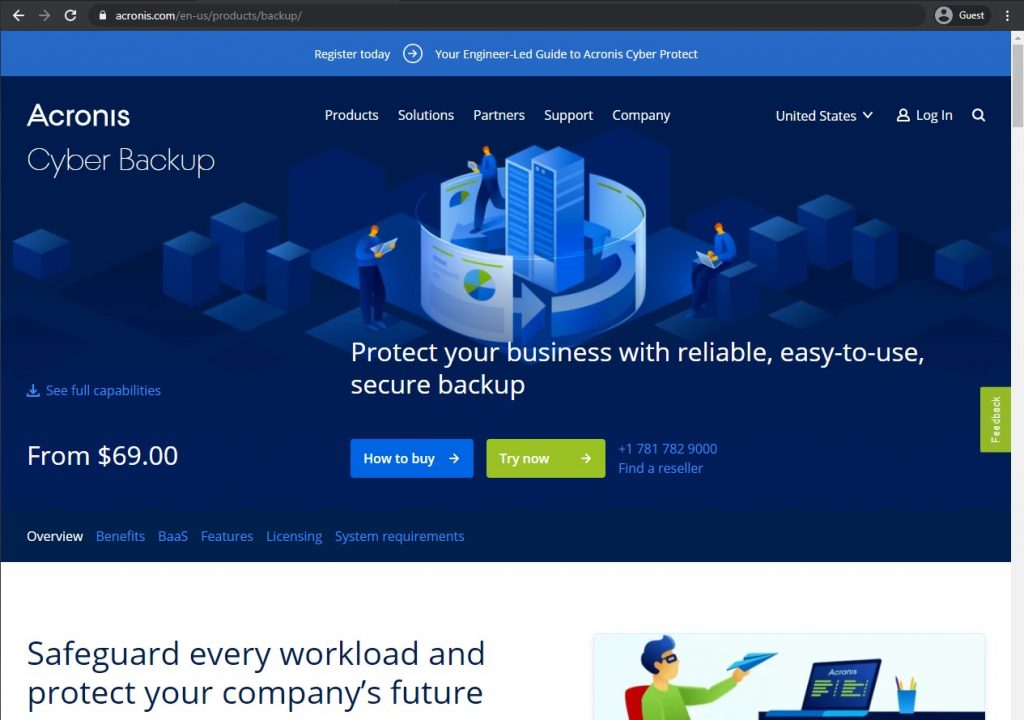
Acronis is a well-known competitor in the software market, and its Cyber Backup solution meets the company’s standards, offering a secure and effective backup solution for multiple use cases. Acronis can protect information from a wide variety of threats, including software failures, hardware problems, cyber-attacks, accidents, and so on. There are additional features within the same field, such as in-depth monitoring and reporting, minimized user downtime, the ability to ensure if a backup is authentic or not, and so on.
Customer ratings:
- Capterra – 4.1/5 stars based on 75 customer reviews
- TrustRadius – 5.9/10 stars based on 139 customer reviews
- G2 – 4.3/5 stars based on 700 customer reviews
Advantages:
- Compatibility with a large variety of workloads
- AI-based malware protection
- Easy data collection operations
Shortcomings:
- The solution’s pricing is significantly above the market average
- The backup agent is incredibly demanding in terms of system hardware
- User interface can be confusing and is often considered outdated
Pricing:
- Acronis Cyber Protect’s backup capabilities differ in pricing, depending on the nature of the backup target:
- From $109 per one workstation, be it physical or virtual, macOS or Windows
- From $779 for one server, be it physical or virtual, Linux or Windows
- From $439 for a 3-pack of public cloud virtual machines
- From $1,019 per one virtual host, be it Hyper-V or VMware (no limitations on the number of virtual machines per host)
- From $209 for 5 seats in Microsoft 365 with full coverage (across SharePoint Online, Teams, OneDrive for Business or Exchange Online)
- Acronis Cyber Protect – Backup Advanced offers file-level backups, image-based backups, incremental/differential backups, ransomware protection, vulnerability assessment, group management, AD integration, reports, and more.
Customer reviews (original spelling):
- Gábor S. – Capterra – “Easy to operate because cloud backup can be performed with the same configuration as on-premises. Pricing is more economical than other services. An introductory one for those who do not use cloud services. We only restored the server as a test, but we converted the image to a model different from the physical server. Servers can be restored even in case of fire or disaster damage.”
- Chase R. – Capterra – “A solid backup solution when it works. Once it works it tends to stay working. The only issues is if it’s not working, you will have to figure it out on your own, next to no support!”
My personal opinion on Acronis:
As a company, Acronis offers backup and recovery software for different use cases, primarily large-scale enterprises. Data security being its biggest focus, Acronis claims to be able to protect its users against cyber-attacks, hardware failures, software issues, and even the ever-present “human factor” in the form of accidental data deletion. Acronis includes AI-based malware protection, extensive backup encryption, and backup-related features that are really good. However, scalability can be limited, integration with some databases, VM’s and containers is limited, its interface can be a touch confusing at times, and the solution itself is often described as “very expensive.” Still, many small and medium companies would gladly pay Acronis to safeguard their data.
Cohesity
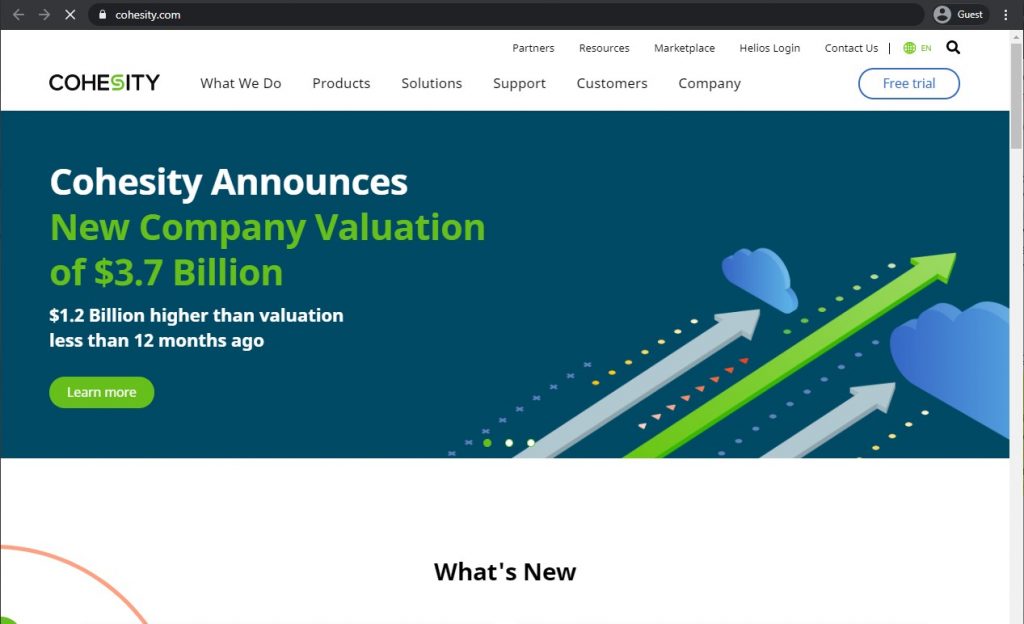
Cohesity is more of a “all-in-one” solution, capable of working with both regular applications and VMs, and its scalability is quite impressive as well, thanks to its cluster-like structure with nodes. It can maintain backups with app-native formats and use NAS protocols to manipulate a variety of data types. Its data restoration speed is also good. Unfortunately, the pricing model isn’t flexible and some specific objectives, like MS Exchange or SharePoint granular recovery, are covered only by separate modules that are also separately priced.
Customer ratings:
- Capterra –4.6/5 stars based on 51 customer reviews
- TrustRadius – 8.5/10 stars based on 86 customer reviews
- G2 – 4.4/5 stars based on 47 customer reviews
Advantages:
- User-friendly interface
- Simple and fast implementation
- Convenience of seeing all clusters on a single screen
Shortcomings:
- Cannot perform backups on a specific date of the calendar
- Database backup process is inconvenient and needlessly convoluted
- Automation capabilities are very basic
- Limited reporting and monitoring
Pricing:
- Cohesity’s pricing information is not publicly available on its official website, making contacting the company directly for a free trial or a guided demo the only way to obtain pricing information.
- Unofficially, Cohesity’s hardware appliances alone have a starting price of $110,000 USD.
Customer reviews (original spelling):
- Justin H. – Capterra – “Backing up entire VM’s through vCenter is a breeze and works well. Application backups (Exchange, SQL, AD) will all require an agent and the agent management is very poor in my opinion. Replication works fine and restore times from locally cached data is quick. There are still a lot of little things that keep this from being a polished solution but the overall product is good.”
- Michael H. – Capterra – “Cohesity has been excellent to work with. The local team is always helpful and responsive, support is excellent, and the product exceeds all expectations. We started small because we were uncertain that they could do all of the things we heard about during the pre-sale process, but we couldn’t be happier with the product. We are currently in the process of tripling our capacity and adding additional features because we were so impressed by every aspect of Cohesity.”
My personal opinion on Cohesity:
Cohesity’s feature set is a good example of a middle-ground enterprise backup solution. It has many of the features expected of a backup solution at this level: support for a variety of data types and storage environments, impressive backup/restoration speed, an impressive list of backup-centric features, and more. What’s interesting about Cohesity is its infrastructure: the entire solution is built using a node-like structure that allows for scalability , both in its speed and its relative ease of use. Cohesity’s interface is rather user-friendly in comparison with other software on the market, but database backup with Cohesity is neither particularly simple nor easy. Cohesity also lacks automation capabilities. Container backup needs much more work and reporting is also limited.
MSP360 (formerly Cloudberry Lab)
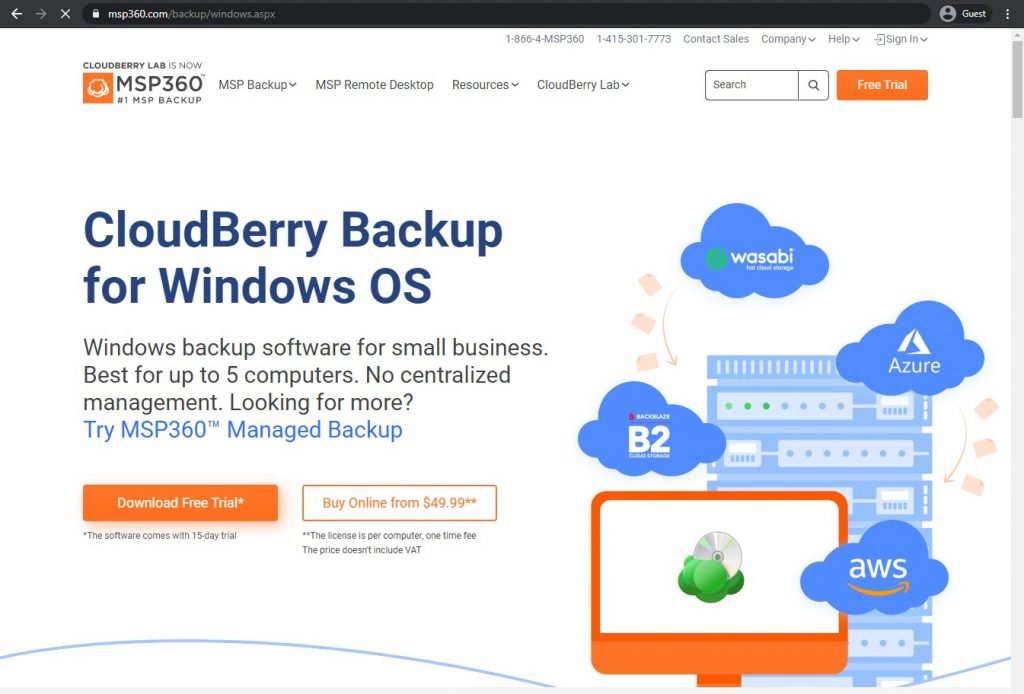
MSP360 is a well-known cross-platform backup and recovery solution, offering integrations with most of the major public cloud storage providers, such as AWS, Azure, Google, etc. MSP360’s backup-related capabilities are vast and varied, including both image-based and file-level backups, disaster recovery in the cloud, high-class encryption and data compression. It is compatible with Mac, Windows and Linux operating systems, providing an unprecedented level of both protection and of disaster recovery capabilities.
Customer ratings:
- Capterra –4.7/5 stars based on 243 customer reviews
- TrustRadius – 7.7/10 stars based on 53 customer reviews
- G2 – 4.5/5 stars based on 508 customer reviews
Advantages:
- Easy initial setup and configuration
- Centralized control over a lot of different information and features from a single page
- Both backup and restore processes are quick and easy
Shortcomings:
- The inconvenience of having to pay an additional price for specific features, such as SQL backups
- Higher than average price may make it unaffordable for small businesses
- Customer service receives a lot of polarizing reviews
Pricing:
- MSP360’s pricing information is not publicly available on its official website, meaning the only way to obtain such information is by contacting the company directly for a quote. Its special “quote calculator” page allows potential customers to specify what specifically they want to be backed up, be it Windows, Mac, Linux devices, VMware, Hyper-V, Microsoft 365, Google Workspace, etc.
Customer reviews (original spelling):
- Andrej P. – Capterra – “Very satisfied, have been using many backup products in past 20 years and now I am happy and satisfied user, re-seller and admin of MSP360 for almost 10 years and have no plans to switch to anything else. Quite a lot of times I use it to restore some files, which users deleted accidentally or overwrote unintentionally, and the process of finding the right version of the file is much, much easier than with many other products.”
- Jim S. – Capterra – “I used to like the ticket support of Cloudberry Labs. I have been a paid maintenance customer since 2013. In the maintenance plan they offer upgrades and support. Even though they enjoy my annual maintenance fees on 9 licenses they refuse to honor the upgrade clause in the agreement. I used to recommend the software and praise the support but in the past year it went downhill fast. They don’t even read the issue in the support ticket and respond otherwise. I don’t not recommend them any more now based upon my real life experience now.”
My personal opinion on MSP360:
MSP360 was originally Cloudberry Labs, a relatively simple backup and recovery solution. Now it has an entire suite of features for all kinds of situations and use cases, be it cloud backups, physical backups, and so on. MSP360 supports several different operating systems, can offer both granular and large-scale backup features, and has enough centralization capabilities to offer complete control over the company’s backup and recovery processes. MSP360’s customer service receives few positive reviews, and the pricing model of the solution also excludes many of its desirable features from the base package (meaning that users looking for SQL backups, for example, must pay extra).
IBM Storage Protect
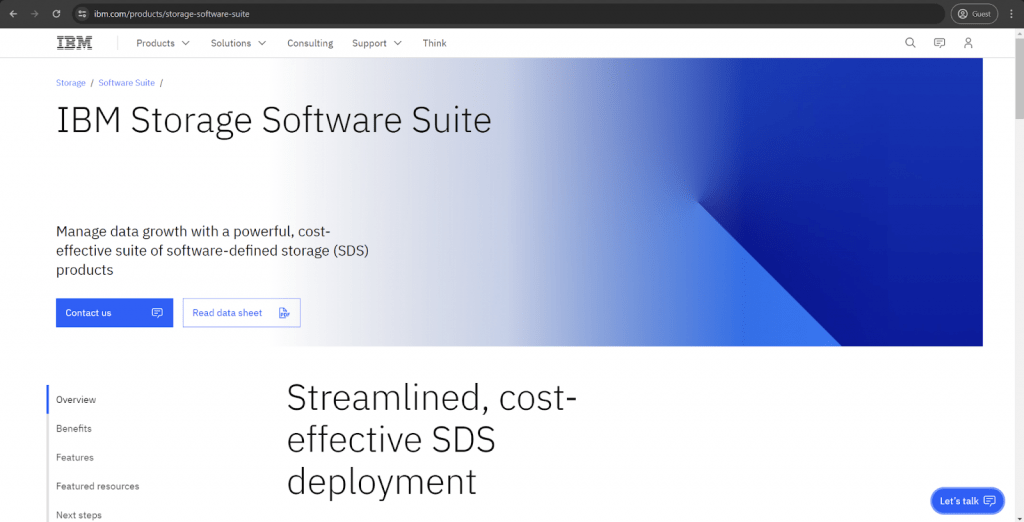
IBM’s primary goal is to simplify data protection, no matter the storage type or data type. IBM Storage Protect (formerly known as Spectrum Protect or Tivoli Storage Manager) is one such solution, offering impressive data protection capabilities at scale, with impressive security capabilities like encryption. There are many more features, like basic backup and recovery jobs, disaster recovery, bare metal recovery, and so on. The solution itself is based on an agentless virtual environment, and it works well with both VMware and Hyper-V environments. The licensing model is charged per TB spent, no matter the data type, which makes it less expensive in some specific cases with large data processing amounts.
Customer ratings:
- TrustRadius –7.8/10 stars based on 41 customer reviews
- G2 – 4.1/5 stars based on 77 customer reviews
Advantages:
- The convenience of having a single backup solution for a complex environment with multiple storage types
- A wealth of backup-related options, such as granular recovery and integration with third-party tools
- Documentation and logging capabilities are highly regarded
Shortcomings:
- Setting up and configuring the solution properly requires time and resources
- The solution’s GUI is confusing and takes time to master
- The complexity of the architecture is significantly higher than average
Pricing:
- The only pricing information that IBM offers to the public is the cost of its IBM Storage Protect for Cloud option, which can be calculated using a dedicated web page.
- There are five primary categories of software that IBM Storage Protect for Cloud can work with, including:
- Microsoft 365 – starting from $1.52 per user per month.
- Microsoft Entra ID – starting from $1.01 per user per month.
- Salesforce – starting from $1.52 per user per month.
- Dynamics 365 – starting from $1.34 per user per month.
- Google Workspace – starting from $1.27 per user per month.
- Note that IBM does offer volume discounts for companies purchasing 500 or more seats at once.
- At the same time, there is a dedicated toggle that can add “unlimited storage in IBM’s Azure Cloud,” which raises most of the above mentioned prices accordingly:
- Microsoft 365 – starting from $4.22 per user per month.
- Salesforce – starting from $4.22 per user per month.
- Dynamics 365 – starting from $3.37 per user per month.
- Google Workspace – starting from $3.18 per user per month.
Customer reviews (original spelling):
- Naveen Sharma – TrustRadius – “Tivoli (TSM) software is best for the policy-based management of file-level backups with automatic data migration between storage tiers. It’s the best way to save on the cost of storage and other resources. I really like the deduplication functionality of source and destination data, which helps to save the network bandwidth and storage resources. The administration of Tivoli is still complex, which means you need good skills to manage this product. Although a new version is coming with a better GUI, it will still require good command-line skills to make Tivoli do everything.”
- Gerardo Fernandez Ruiz – TrustRadius – “If you also need to have an air-gapped solution, Spectrum Protect has the option of sending the backup to tape (and it can also replicate the information to another site if needed).”
My personal opinion on IBM Spectrum:
IBM Spectrum is a relatively unknown backup solution from a well-known technological company. This is the same company that is primarily known for its hardware rather than its software. However, IBM Spectrum is a good backup and recovery solution for large companies – it is simple, feature-rich, agentless, and supports many different storage types. It also excels at reporting and logging, areas often perceived as the weakest part of enterprise backup solutions. The solution in question can be a bit difficult to configure initially, , the overall interface of the solution can be rather confusing, and the individual elements of the solution can create real difficulty. But as a whole, the solution is rather impressive.
Dell Data Protection Suite
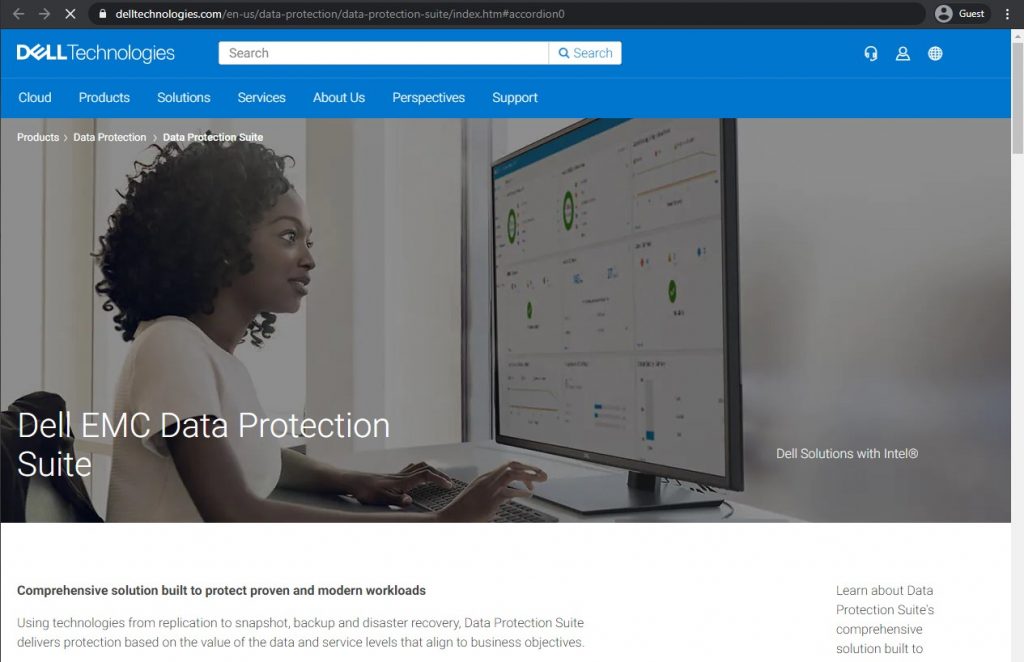
Dell Data Protection Suite is a comprehensive data protection solution suitable for the majority of companies of any size. Data protection levels are variable, user-friendly UI allows for easy data protection visualization, and built-in continuous data protection technology (CDP) allows for fast recovery times for VM environments. The package includes a number of different applications, as well, like separate backups in the cloud, support for more storage types, data isolation/data recovery/data analytics automatization, and so on.
Customer ratings:
- TrustRadius – 8.0/10 stars based on 6 customer reviews
- G2 – 4.1/5 stars based on 20 customer reviews
Advantages:
- Support for plenty of different OS types
- Great for large databases and enterprises
- Interface user-friendliness
Shortcomings:
- Backups could fail if some elements in the system have changed since the last backup.
- Error reports are somewhat confusing
- Customer support is lacking
Pricing:
- Dell Data Protection Suite’s pricing information is not publicly available on its official website and the only way to obtain such information is by contacting the company directly for a quote or a demo.
- Unofficial information suggests that Dell’s pricing starts at $99 per year per single workspace.
Customer reviews (original spelling):
- Cem Y. – G2 – “I like Dell Data Protection very much because it helps me to protect my personal computers as well as my work computers against malicious attacks. It has a very user friendly interface. You can protect your passwords, personal information perfectly. There are some properties of Dell Data Protection. I don’t understand some reports that it produces. It is hard to figure out what the problem is and which solution I need to apply. Its price could also be much more affordable. There may be some different price policies.”
- Chris T. – G2 – “The compliance reporting dashboard is terrific as it provides a quick overview of endpoint compliance. This tool is very taxing on older systems particularly when it does its initial encryption pass of the entire drive.”
My personal opinion on Dell Data Protection Suite:
Dell Data Protection Suite is another good example of enterprise backup software from a company best known for its hardware appliances. Dell Data Protection Suite is not the first iteration of a backup solution from Dell, but it is a decent enterprise backup tool. It offers a user-friendly interface, plenty of centralization capabilities, a variety of features and functions in the realm of backup operations, and more. It supports many different operating systems and storage types, making it a great fit for large-scale businesses and enterprises. At the same time, the solution has its share of problems, from inconsistent customer support reviews to confusing backup error messages, and certain of its technologies and reporting capabilities are limited.
Vembu BDR Suite
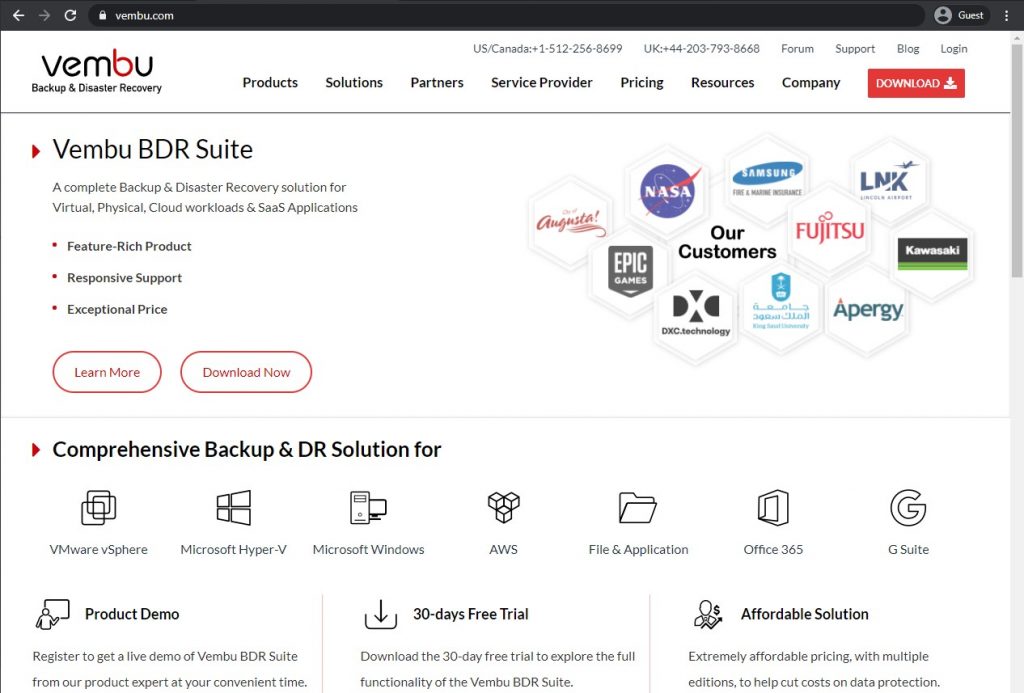
Data protection complexity is one of the prime selling points of Vembu’s solution, and it claims to be useful for companies of any size. Its feature list is quite extensive, as well, including VMware backup, Windows Image backup, app backup, data replication, and so on. Its configuration time is shorter than that of many of its competitors, and many users praise its overall system responsiveness. However, it can be somewhat too complicated at times, and some users find that annoying.
Customer ratings:
- Capterra – 4.4/5 stars based on 22 customer reviews
- TrustRadius – 8.3/10 stars based on 101 customer reviews
- G2 – 4.3/5 stars based on 155 customer reviews
Advantages:
- Helpful and responsive customer support
- Web-based user interface is fairly convenient and user-friendly
- There is a full-fledged Linux version of the solution
Shortcomings:
- A significant price increase across the board at the end of the previous year
- Steep learning curve
- Customer support seems most familiar with the Windows version, which may lead to confusion about the Linux versions
Pricing:
- Vembu’s BDR Suite’s pricing has been recently hidden from the company’s official pricing page, which now lists the specifics of only a licensing model. Vembu uses:
- Endpoint/Workstation backups are priced per endpoint.
- Server backups are priced per server.
- NAS/File Share backups are priced per 500 GB of storage.
- SaaS backups are priced per user.
- VM & Cloud VM backups are priced per VM.
- DBs and Applications backup are priced per application.
- It is also worth noting that most of the BDR Suite’s backup solutions are also available for free with most of the features but a strict limit on the number of workstations/VMs/servers it can work with.
Customer reviews (original spelling):
- Francesco Z. – Capterra – “Overall, I give BDRSuite 8/10 and would recommend it to anyone wanting to get a reliable backup solutions”
- Daniel E. – Capterra – “Overall the software is great for being free. I wouldn’t be confident or as likely to recommend it as a purchased product at the price point they are asking. Their whole product and documentation need improvement before I would have confidence in recommending it to other companies that would use it in their production environment.”
My personal opinion on Vembu:
Unlike most of the solutions on this list, Vembu focuses its software development efforts on just two solutions: BDR Suite and BDR Cloud. These two solutions can be considered one and the same, to a certain degree, since BDR Cloud is just a feature-limited version of BDR Suite that works from the cloud instead of physical deployment. BDR Suite, on the other hand, is an incredible enterprise data backup solution with a truly massive set of features. It supports many storage types and environment variations, while also offering relatively rapid recovery times and response speed. However, it is also rather complex software – one of the most complex data backup solutions for enterprises on this list. As such, any potential user should keep the overall complexity of this software in mind as a possible disadvantage.
Veritas Backup Exec
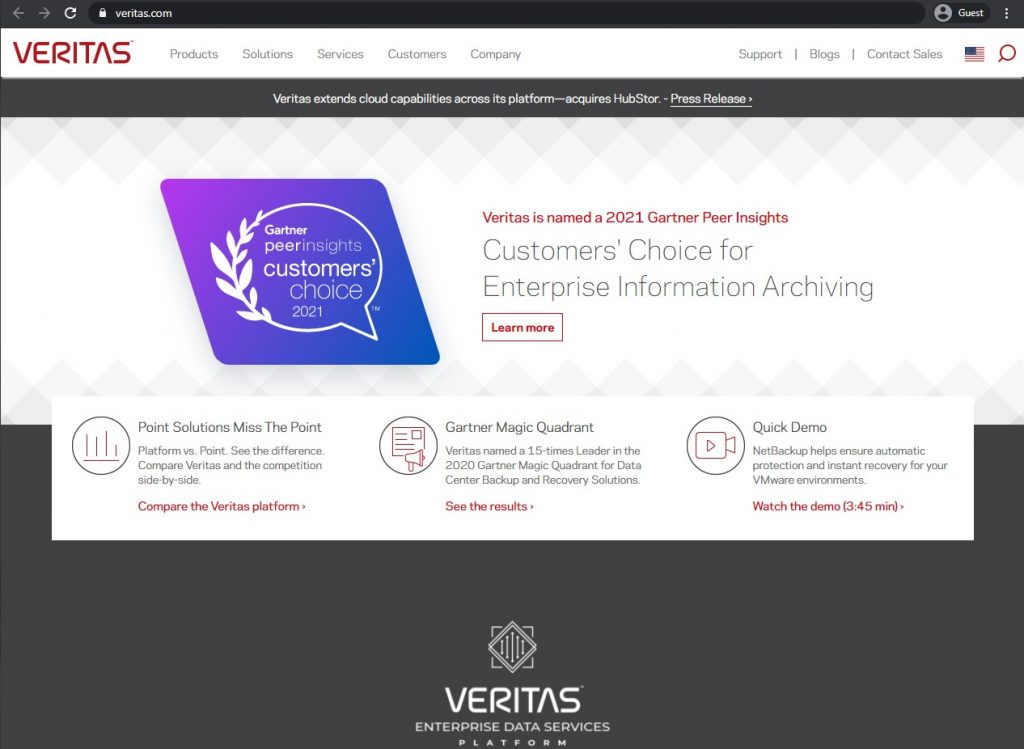
Veritas has a long history, with several decades of company success. Its backup and recovery capabilities are quite extensive, including information governance, cloud data management, and other brand-new functions. Two versions of the solution are available: the deployable version or the integratible appliance. Veritas is highly favored by older, legacy, companies that prefer services that have proven themselves with time. However, users report problems with hardware scaling capacity, as well as occasional ’niggles’.
Customer ratings:
- Capterra – 4.2/5 stars based on 12 customer reviews
- TrustRadius – 6.9/10 stars based on 163 customer reviews
- G2 – 4.2/5 stars based on 272 customer reviews
Advantages:
- The sheer number of features available to customers
- Praise-worthy GUI
- Excellent customer support
Shortcomings:
- Working with LTO tape libraries is problematic
- Reports cannot be exported to a PDF file without Adobe Reader installed on that same system
- Automated reports cannot be saved to a different location on to a different server
Pricing:
- Veritas’s pricing information is not publicly available on its official website, meaning the only way to obtain such information is by contacting the company directly.
Customer reviews (original spelling):
- Mark McCardell – TrustRadius – “Veritas Backup Exec is best suited for <1PB environments that deal with typical Windows & Linux file storage arrays. Once you delve into more sophisticated storage environments, there are no available agents for those environments.”
- Taryn F. – Capterra – “Veritas Backup Exec is a good choice for small to medium businesses with a relatively simple set up , not requiring many different agents to be backed up, and without excess amounts of data. The licensing model is complicated and can be expensive, but I have seen great changes in the options supplied now – such as the Per VM model”
My personal opinion on Veritas:
Veritas can be considered an average enterprise backup solution, to a certain degree: it offers most of the features that one would expect in a similar solution, be it support for many different environments or a variety of features for data security, data backups, etc. The distinguishing feature of Veritas is, to a certain degree, its legacy. Among backup software providers, Veritas is a very old company, even by this market’s standards – and it has accumulated many Many older and more cnoservative businesses hope to have Veritas’s experience and reputation, which is why Veritas still has plenty of clients and gains newer ones on a regular basis. Veritas also has several very specific shortcomings, such as the lack of proper LTO tape support as backup storage, which can be a massive detriment for specific users.
NAKIVO
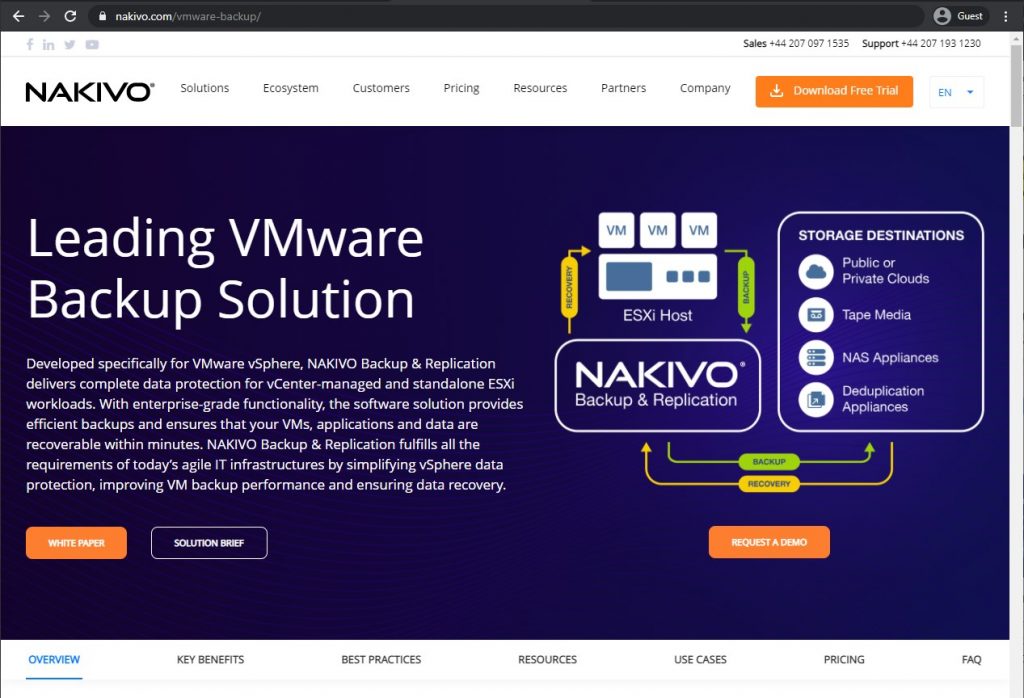
Nakivo Backup & Replication is another competitor on the list that is developed by a much larger company. Its backup solution is reliable, fast, and can work with both cloud and physical environments, offering enterprise-grade data protection and a whole package of other features. Some of these features are: file recovery on-demand, incremental backup for different platforms, low backup size, impressive overall performance, all of which is packageed in an easy-to-use UI.
Customer ratings:
- Capterra – 4.8/5 stars based on 427 customer reviews
- TrustRadius – 9.3/10 stars based on 182 customer reviews
- G2 – 4.7/5 stars based on 278 customer reviews
Advantages:
- Easy to install and configure
- Simple and clean user interface
- Noteworthy customer support
Shortcomings:
- Error logging is limited and cannot always help to determine the cause of the error
- Limited support for physical servers running on Linux
- Higher than average price tag
Pricing:
- NAKIVO’s pricing can be split into two main groups:
- Subscription-based licenses:
- “Pro Essentials” – from $1.95 per month per workload, covers most common backup types such as physical, virtual, cloud and NAS, while also offering instant granular recovery, virtual and cloud replication, storage immutability, and more
- “Enterprise Essentials” – from $2.60 per month per workload, adds native backup to tape, deduplication appliance integration, backup to cloud, as well as 2FA, AD integration, calendar, data protection based on policies, etc.
- “Enterprise Plus” does not have public pricing available, it adds HTTP API integration, RBAC, Oracle backup, backup from snapshots, and other features
- There is also a subscription available for Microsoft 365 coverage that costs $0.80 per month per user with an annual billing and can create backups of MS Teams, SharePoint Online, Exchange Online, OneDrive for Business, and more
- Another subscription from NAKIVO is its VMware monitoring capabilitiy that comes in three different forms:
- “Pro Essentials” for $0.90 per month per workload with CPU, RAM, disk usage monitoring and a built-in live chat
- “Enterprise Essentials” for $1.15 per month per workload that adds AD integration, 2FA capability, multi-tenant deployment, and more
- “Enterprise Plus” with no public pricing that adds RBAC and HTTP API integrations
- The Real-time Replication pricing tier offers the feature of the same name for VMware vSphere environments for $2.35 per month per workload with 2FA support and Microsoft AD integration.
- All prices mentioned above are part of a three-year plan; shorter contracts can have different pricing points.
- Perpetual licenses:
- Virtual environments:
- “Pro Essentials” for $229 per socket, covers Hyper-V, VMware, Nutanix AHV, and features such as instant granular recovery, immutable storage, cross-platform recovery, etc.
- “Enterprise Essentials” for $329 per socket, adds native backup to tape, backup to cloud, deduplication, 2FA, AD integration, and more
- “Enterprise Plus” with no public pricing that adds RBAC and HTTP API integrations, as well as backup from storage snapshots
- Servers:
- “Pro Essentials” for $58 per server, covers Windows and Linux, and features such as immutable storage, instant P2V, instant granular recovery, etc.
- “Enterprise Essentials” for $76 per server, adds native backup to tape, backup to cloud, deduplication, 2FA, AD integration, and more
- “Enterprise Plus” with no public pricing that adds RBAC and HTTP API integrations
- Workstations:
- “Pro Essentials” for $19 per workstation, covers Windows and Linux, and features such as immutable storage, instant P2V, instant granular recovery, etc.
- “Enterprise Essentials” for $25 per workstation, adds native backup to tape, backup to cloud, deduplication, 2FA, AD integration, and more
- “Enterprise Plus” with no public pricing that adds RBAC and HTTP API integrations
- NAS:
- “Pro Essentials” for $149 per one Terabyte of data, can backup NFS shares, SMB shares, folders on shares, and offer file level recovery
- “Enterprise Essentials” for $199 per one Terabyte of data, adds AD integration, 2FA support, calendar, multi-tenant deployment, etc.
- “Enterprise Plus” with no public pricing that adds RBAC and HTTP API integrations
- Oracle DB:
- “Enterprise Plus” is the only option available for Oracle database backups via RMAN, it can offer advanced scheduling, centralized management, and more for $165 per database.
- VMware monitoring:
- “Pro Essentials” for $100 per socket with CPU, RAM, disk usage monitoring and a built-in live chat
- “Enterprise Essentials” for $150 per socket that adds AD integration, 2FA capability, multi-tenant deployment, and more
- “Enterprise Plus” with no public pricing that adds RBAC and HTTP API integrations
- Real-time Replication:
- Enterprise Essentials for $550 per socket with a basic feature set.
- Enterprise Plus with no public price tag that offers RBAC support, HTTP API integration, etc.
- Virtual environments:
Customer reviews (original spelling):
- Ed H. – Capterra – “We got tired of the massive cost of renewals from our past backup software providers and decided to try Nakivo instead. They supported our need for Nutanix AHV, QNAP and Tape backups. I’m looking forward to trying the new PostgreSQL database option soon so that I can build my own reports. Nakivo gets the job done and gets better with each version.”
- Joerg S. – Capterra – “We are using Nakivo B&R for our new server with quite a number of virtual machines (VM Ware). Backup of data is onto a Synology via 10GB/s. The backup makes use of all available network speed. Once you understand how it works, its configuration is straightforward. Whenever we experienced some issues, Nakivo Service was very helpful (GoTo meeting) and pretty fast (next day at the latest). So far no complaints on their response.”
My personal opinion on NAKIVO:
NAKIVO may not have decades of experience, and it is definitely not the most feature-rich solution on this market. However, none of these factors make NAKIVO a poor choice of enterprise data backup software. Quite the contrary, it is a versatile enterprise backup and recovery system that is fast, responsive, and relatively easy to work with. NAKIVO offers on-demand file recovery, impressive backup performance, easy first-time configuration, and an impressive customer support team. However, it is worth noting that NAKIVO’s services are rather expensive, and it also has the bane of most backup solutions: lackluster reporting and logging capability. Storage destinations are also limited.
NetApp SnapCenter
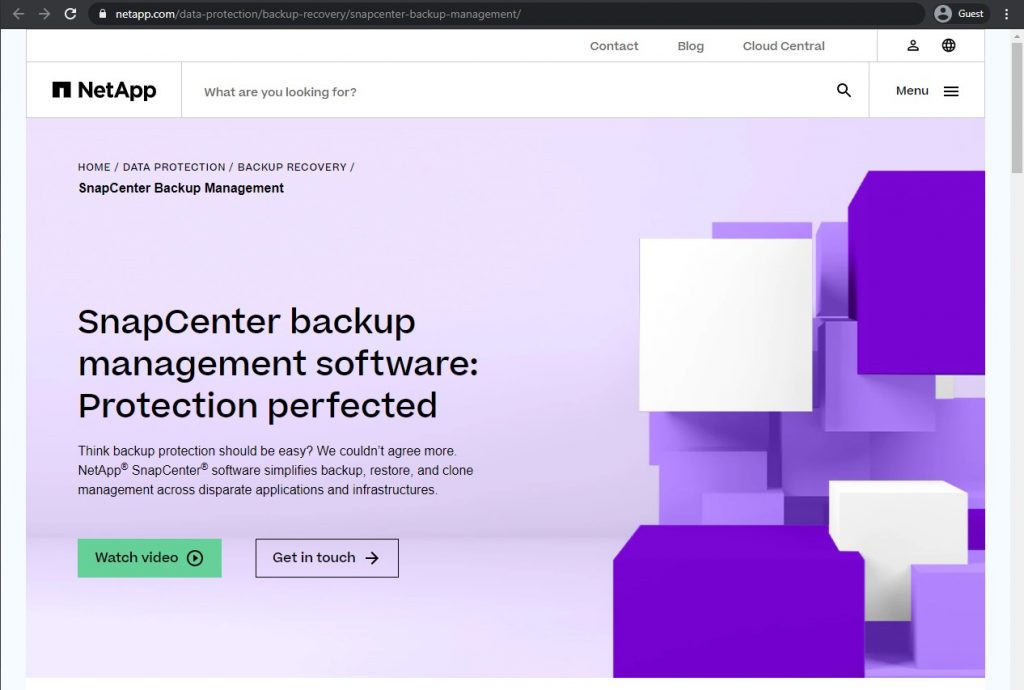
NetApp’s power is its availability, with more than 150 offices all over the world, it is capable of providing local support around the world. There are a range of different backup and recovery-related functions, with the ability to have access to data via laptop or even a mobile phone. There’s a centralized interface for monitoring, scheduling and logging, and it supports a variety of different data types, from apps and databases to MS Exchange servers, VMs, and so on. Its response times are good and, according to user reviews, its centralization is quite handy. But there are also problems with customer experience here and there, as well as concerns over the thoroughness of its documentation.
Customer ratings:
- Capterra – 4.5/5 stars based on 8 customer reviews
- TrustRadius –8.0/10 stars based on 3 customer reviews
- G2 – 3.8/5 stars based on 2 customer reviews
Advantages:
- A significant part of the cloning process is automated
- User-friendly solution with few complex settings or menus
- Remote backup capabilities are praise-worthy
Shortcomings:
- A decent number of bugs throughout the solution
- Limited customer support
- Restoring Linux servers remotely is not allowed
Pricing:
- NetApp’s pricing information is not publicly available on its official website , making contacting the company directly for a free trial or a “test drive” the only way to obtain such information.
- The unofficial information suggests that NetApp SnapCenter’s average subscription fee starts at $1,410 per year.
Customer reviews (original spelling):
- Jesse S. – Capterra – “SnapCenter was great for a transition to another data center. It was fast and easy for us to transfer all of our data. Our storage filled with change logs and stopped backing up without any notification.”
- Sarthak P. – Capterra – “It is good and easy to deploy and use. Also, does offer quick and easy restoration of VM’s offered by VMWare”
My personal opinion on NetApp:
NetApp SnapCenter is a relative unknown among this list of enterprise data backup solutions, even though it is quite competent in its own regard. NetApp offers backup centralization, a variety of scheduling options, many backup-related features, and support for several different storage types. Backups created with the solution are accessible by practically any device that has a web browser, including laptops and mobile phones. NetApp is also one of the few solutions that has offices all over the world, providing local support for companies in specific countries – something that most competitors don’t do at all. It is worth noting that the solution itself is not bug-free, , and its Linux capabilities are rather limited in comparison with the Windows feature set.
Commvault
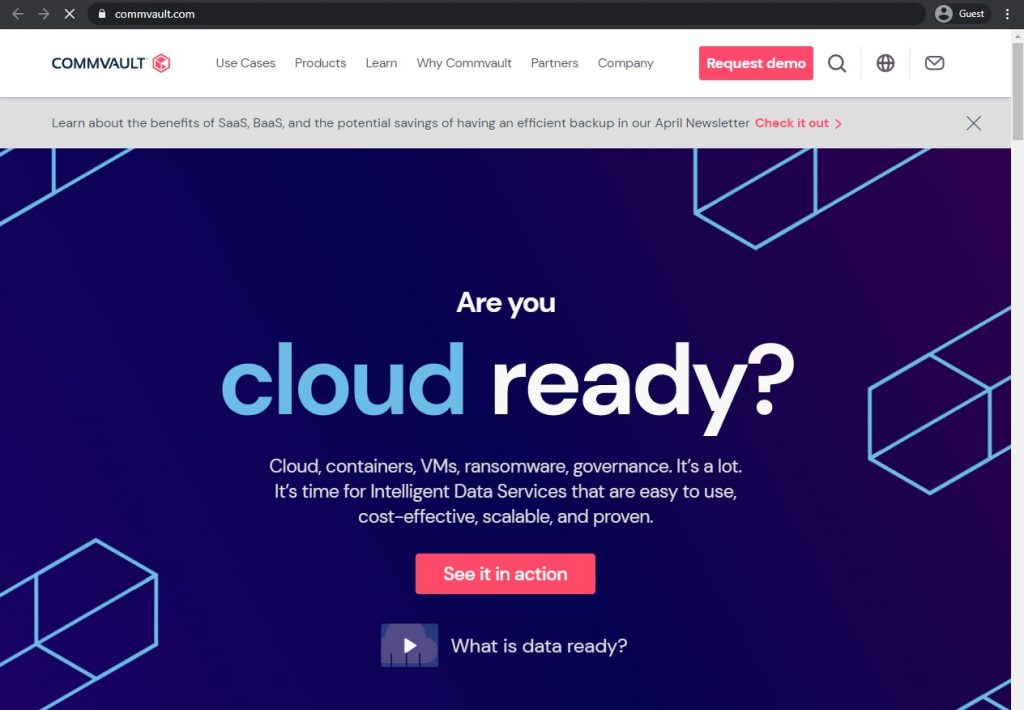
Commvault focuses on applying cutting-edge technologies in their data backup and recovery solution to provide the best experience possible with various file types, data sources, backup types and storage locations. Commvault is known for its pinpoint accuracy backups for VMs, databases or endpoints, VM recovery, unstructured data backup, data transfer, etc. Commvault can integrate with more than a dozen cloud storage providers, including VMware, AWS, Azure, and many more. On the other hand, there are some areas that are less well-developed, according to some customer reviews, such as UI friendliness.
Customer ratings:
- Capterra – 4.6/5 stars based on 47 customer reviews
- TrustRadius – 7.7/10 stars based on 226 customer reviews
- G2 – 4.4/5 stars based on 160 customer reviews
Advantages:
- Easy connection with complex IT infrastructures
- A significant number of integrations to choose from
- Backup configuration is simple
Shortcomings:
- Not the most beginner-friendly solution on the market
- Takes a rather significant amount of time to set up and configure
- Basic logging functions are lacking
Pricing:
- Commvault’s pricing information is not publicly available on its official website, meaning the only way to obtain such information is by contacting the company directly for a demo showcase or a free 30-day trial.
- Unofficial information suggests that Commvault’s hardware appliances’ price ranges from $3,400 to $8,781 per month.
Customer reviews (original spelling):
- Sean F. – Capterra – “We’ve been using Commvault’s backup product for several years now and although a complex product due to all it can do it is still the best I’ve used in a corporate environment. In my opinion it really is only for larger businesses but I can see how a small business could still get some benefits from the product. We use it to backup our File, Email, Database servers and all of our VMware virtual infrastructure. As everything is located in one console you don’t have to go far to find what you need and there are agents for nearly any operating system or application typically used in an enterprise environment.”
- Doug M. – Capterra – “As the title says “Migrated to Hyperscale and no looking back”. We have great sales people and excellent support from Commvault.”
My personal opinion on Commvault:
Commvault is a relatively standard enterprise-grade backup solution that uses a variety of cutting-edge technologies to provide the best possible user experience to its customers. Commvault works with containers, cloud storage, VMs, databases, endpoints, and more. It delivers a fast and accurate backup and recovery experience, can be integrated with a variety of cloud storage providers, and backup tasks are relatively easy to set upwith it. However, Commvault can be quite expensive. At the same time, Commvault lacks the ability to logand report data for most of its features, and its first-time setup is notoriously long and complicated.
Asigra
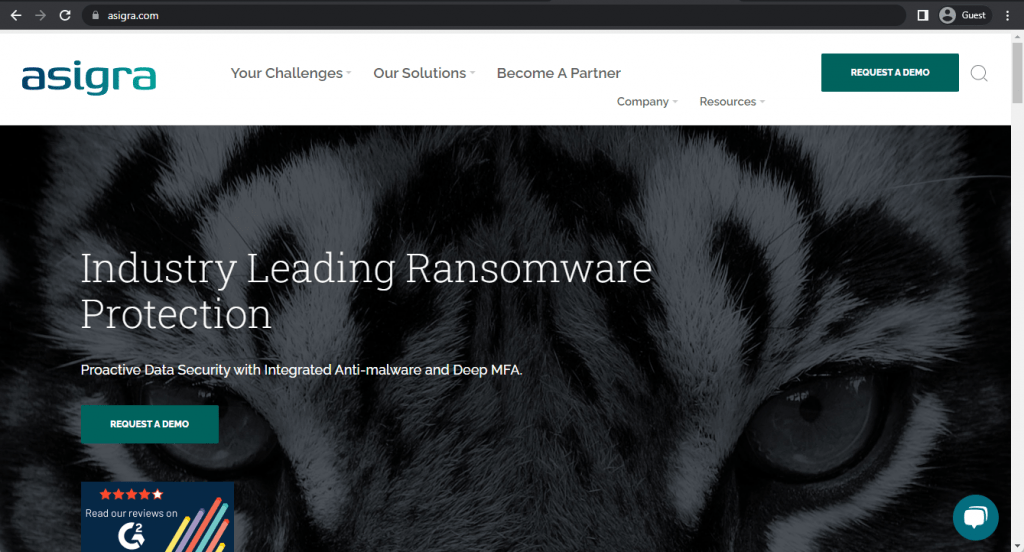
Asigra has been on the market for some time now, earning its reputation over more than thirty years of experience in the field. Asigra now offers a data recovery solution to its clients from anywhere in the world, taking advantage of a wide partner network, with cloud backup and recovery services for different deployment types. Asigra is an agentless enterprise-class recovery software that supports servers, databases, and VMs, endpoint devices, applications, and more. It can also eliminate backup data silos, reduce RTOs, and claims to guarantee recovery in any case.
Customer ratings:
- TrustRadius – 7.8/10 stars based on 39 customer reviews
- G2 – 4.2/5 stars based on 82 customer reviews
Advantages:
- Extremely convenient agentless backups for different storage types
- Restore validation is quick and easy, figuring out the state of any backup in a very short time frame
- Restore process automation is extremely convenient
Shortcomings:
- Feature implementation speed is slower than most of its competitors
- Different storage types may not be compatible with each other, such as S3 storage and extensible storage
- The number of support calls per year is limited
Pricing:
- Asigra’s pricing information is not publicly available on their official website, meaning the only way to obtain such information is by contacting the company directly for a demo showcase.
Customer reviews (original spelling):
- Neel Shah – TrustRadius – “The majority of the problems that have come up in my use of the software have been resolved by Asigra’s support personnel, who are very knowledgeable, and their help site’s extensive knowledge base.I adore the agentless backup technology from Asigra. In our customer’s setup, I can install the DS-Client on a single machine, and it will backup every system connected to that network. I don’t need to set up the programme on numerous computers.”
- Mauro Carrillo – TrustRadius – “Asigra does a great job at automating efficient backup jobs. We can schedule and automate the backup process, thus reducing the need for manual intervention and freeing up IT resources that allows them to work on other IT projects and activities. The Asigra process is extremely efficient. It’s appropriate for any size business.”
My personal opinion on Asigra:
Asigra has been around for about three decades now, going through several rebrandings, while still managing to provide a respectable level of backup and recovery capabilities. Despite its rebrandings over the years, Asigra remains a noteworthy backup solution, with an agentless structure that supports endpoints, VMs, applications, and regular data storage. Asigra’s contracts with a variety of cloud storage providers and integrations with other services ensure the safety and accessibility of all client data. Asigra claims to be able to eliminate data backup silos, but its feature implementation speed is slower than with most of its competitors, and there is also a limit on how many support calls a regular user can make in a year, a very unusual approach to customer support.
Carbonite Endpoint
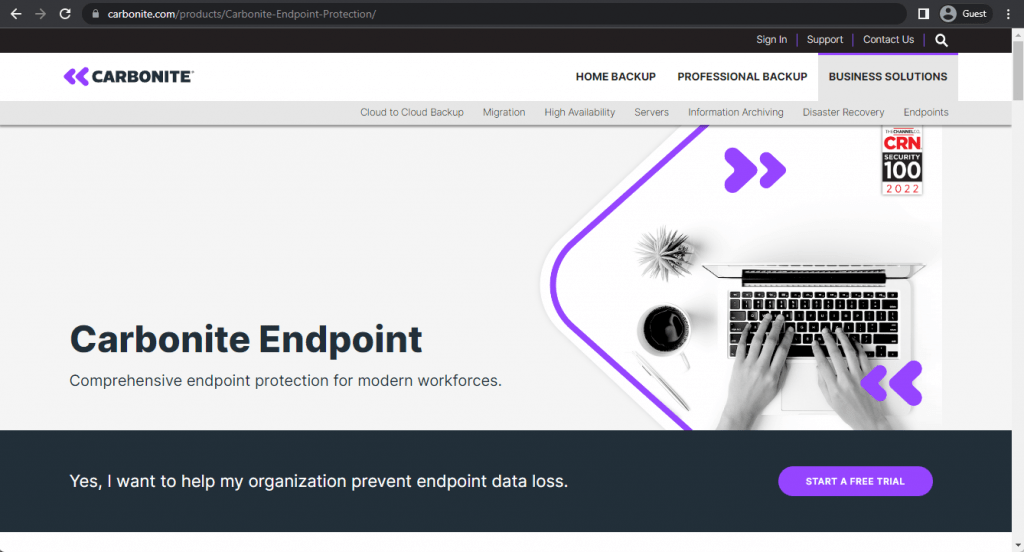
As its name suggests, Carbonite Endpoint focuses on protecting endpoint data – information that resides in users’ smartphones, tablets, computers and laptops. Carbonite uses multiple different technologies, such as global deduplication and file-level backup, to improve data recovery speed and manage bandwidth of the backup and recovery processes. It can also interact with servers and external hard drives, offering a great deal in terms of security for data without overpaying for it. The solution itself is fairly easy to use and is a great deal in terms of price for the feature set.
Customer ratings:
- Capterra – 4.2/5 stars based on 171 customer reviews
- TrustRadius –8.4/10 stars based on 65 customer reviews
Advantages:
- Backups are checked regularly for ransomware and other malware types
- Initial setup is quick and easy
- Overall user experience with the solution is praise-worthy
Shortcomings:
- Slow administrative interface
- Difficult to specify which files and folders to back up
- Some of the files are ignored by the solution (for example if the symbol ~ is in the name)
Pricing:
- Carbonite’s pricing information is not publicly available on its official website, meaning the only way to obtain such information is by contacting the company directly for a consultation.
Customer reviews (original spelling):
- Dustin D. – Capterra – “I really liked it until they implemented the HUGE price increase. Perhaps it was a problem with just that one employee but they definitely need to get better at communicating changes to their customers. I’ll be switching to a more cost effective product once our subscription is up.”
- Susan A. – Capterra – “Since it runs in the background and I don’t need to do anything with it – my experience is awesome! I love seeing the reports pop on the screen saying my system just backed up XXXXXXX number of files. And at any time, I can open the software and see the files and view my backup on the Cloud. I am using Carbonite Safe CE 22.2 — I have clients that say they have a backup to Google or other service, and quite frankly they don’t understand the complexity they will go through to try to retrieve their data
My personal opinion on Carbonite Endpoint:
Carbonite Endpoint’s solution differs from most of the examples on this list. Carbonite’s feature set is rather limited, focusing its efforts on the single goal of protecting endpoints. It’s not uncommon for modern companies and enterprises to have hundreds or even thousands of devices connected to the same internal system, and protecting each device in this scenario can be a significant challenge. Carbonite was created to solve this single issue, offering complete protection of every single endpoint in a system, using encryption, granular backups, data deduplication, and more. It is relatively inexpensive and easy to work with, but it is not a complete backup and recovery by design, so it will require at least one more backup software product to achieve full data protection on a company level.
Druva
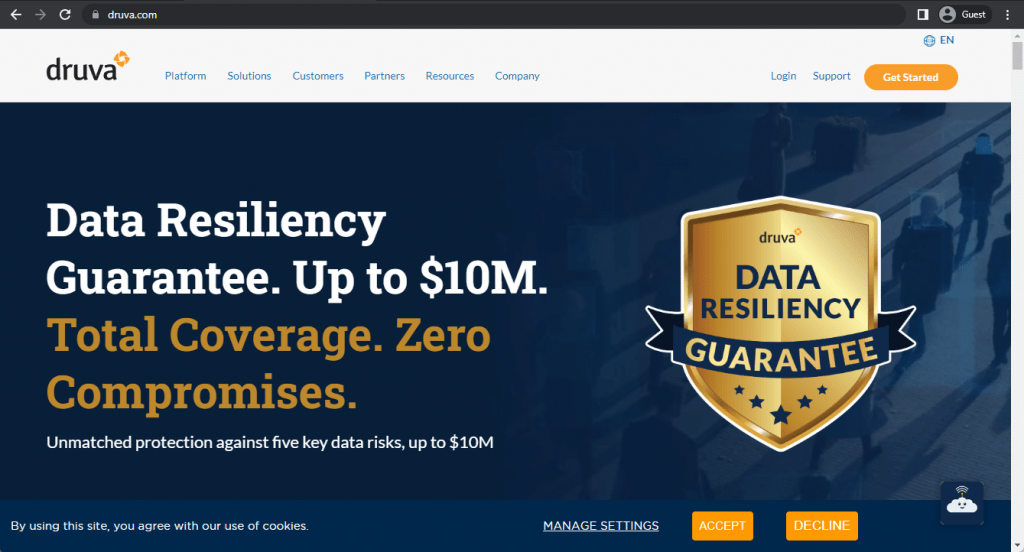
It is fairly common for any company now to have its data spread across hundreds of different devices due to workforce mobility and the rapid rise in various cloud services. Unfortunately, this change also makes it rather difficult to make sure that each and every device with the company’s data is properly protected. Services like Druva Cloud Platform are useful in these situations, offering a wealth of data management options across different devices and applications. The platform itself works as-a-service and offers easier backup and recovery operations, better data visibility, less complex device management, and a range of regulatory and compliance operations.
Customer ratings:
- Capterra – 4.7/5 stars based on 17 customer reviews
- TrustRadius – 9.7/10 stars based on 489 customer reviews
- G2 – 4.7/5 stars based on 614 customer reviews
Advantages:
- GUI as a whole receives a lot of praise
- Backup immutability and data encryption are just an example of how serious Druva is when it comes to data security
- Customer support is quick and useful
Shortcomings:
- First-time setup is not easy to perform
- Windows snapshots and SQL cluster backups are simplistic and barely customizable
- Slow restore speed from cloud
Pricing:
- Druva’s pricing is fairly sophisticated, with different pricing plans depending on the type of device or application that is covered. The actual pricing values have also now been deleted from its public facing web page, leaving only a detailed explanation of the pricing model itself intact.
- Hybrid workloads:
- “Hybrid business” – calculated per Terabyte of data after deduplication, offering an easy business backup with plenty of features such as global deduplication, VM file level recovery, NAS storage support, etc.
- “Hybrid enterprise” – calculated per Terabyte of data after deduplication, an extension of the previous offering with LTR (long term retention) features, storage insights/recommendations, cloud cache, etc.
- “Hybrid elite” – calculated per Terabyte of data after deduplication, adds cloud disaster recovery to the previous package, creating the ultimate solution for data management and disaster recovery
- There are also features that Druva sells separately, such as accelerated ransomware recovery, cloud disaster recovery (available to Hybrid elite users), security posture & observability, and deployment for U.S. government cloud
- SaaS applications:
- “Business” – calculated per user, the most basic package of SaaS app coverage (Microsoft 365 and Google Workspace, the price is calculated per single app), can offer 5 storage regions, 10 GB of storage per user, as well as basic data protection
- “Enterprise” – calculated per user for either/or Microsoft 365 or Google Workspace coverage with features such as groups, public folders, as well as Salesforce.com coverage (includes metadata restore, automated backups, compare tools, etc.)
- “Elite” – calculated per user for Microsoft 365/Google Workspace, Salesforce, includes GDPR compliance check, eDiscovery enablement, federated search, GCC High support, and many other features
- Some features here can also be purchased separately, such as Sandbox seeding (Salesforce), Sensitive data governance (Google Workspace & Microsoft 365), GovCloud support (Microsoft 365), etc.
- Endpoints:
- “Enterprise” – calculated per user, can offer SSO support, CloudCache, DLP support, data protection per data source, and 50 Gb of storage per user with delegated administration
- “Elite” – calculated per user, adds features such as federated search, additional data collection, defensible deletion, advanced deployment capabilities, and more
- There are also plenty of features that could be purchased separately here, including advanced deployment capabilities (available in the Elite subscription tier), ransomware recovery/response, sensitive data governance, and GovCloud support.
- AWS workloads:
- “Freemium,” a free offering from Druva for AWS workload coverage, can cover up to 20 AWS resources at once (no more than 2 accounts), while offering features such as VPC cloning, cross-region and cross-account DR, file-level recovery, AWS Organizations integration, API access, etc.
- “Enterprise” – calculated per resource, starting from 20 resources, withan upper limit of 25 accounts. Extends feethe previous version’s capabilities with features such as data lock, file-level search, the ability to import existing backups, the ability to prevent manual deletion, 24/7 support with 4 hours of response time at most, etc.
- “Elite” – calculated per resource, with no limits on managed resources or accounts, adds auto-protection by VPC and AWS account, as well as GovCloud support, and guaranteed support response time of less than 1 hour
- Users of Enterprise and Elite pricing plans can also purchase Druva’s capability to save air-gapped EC2 backups to Druva Cloud, for an additional price.
- Druva’s pricing scheme is quite confusing. Luckily, Druva has a webpage dedicated to creating a personalized estimate of a company’s TCO with Druva in just a few minutes (a pricing calculator).
Customer reviews (original spelling):
- Andy T. – Capterra – “Our original POC when testing this product was very thorough and we were given ample time to test it and make sure it was going to fit how we needed it. Setting it up was incredibly easy and we were able to figure out a lot of the features on our own with minimal help. When we needed help, the team we were working with was great. We also had to work with support and that was great as well.”
- Dinesh Y. – Capterra – “My experience with Druva endpoint is amazing. From the time of onboarding this software I am not worried about data loss of the users. But I think Druva should consider more discount for NGO’s as well as corporate so that everyone can use it extensively.”
My personal opinion on Druva:
Druva’s cloud backup platform was specifically developed to solve the common problem of managing hundreds of different devices within the same system, which is why it is rather obvious that Druva’s solution targets mainly large businesses and enterprises. The solution itself is provided on a SaaS basis, and is capable of protecting many different kinds of devices, including endpoints, databases, VMs, physical storage, and so on. Druva’s solution offers a wealth of backup and recovery features, impressive data protection capabilities, and compliance with many legal and regulatory matters. Druva’s pricing model is rather confusing, and first-time setup is not an easy process, and it is unlikely to work well for an organization with large data volumes. Integration with some VM’s and databases is also very limited.
Zerto
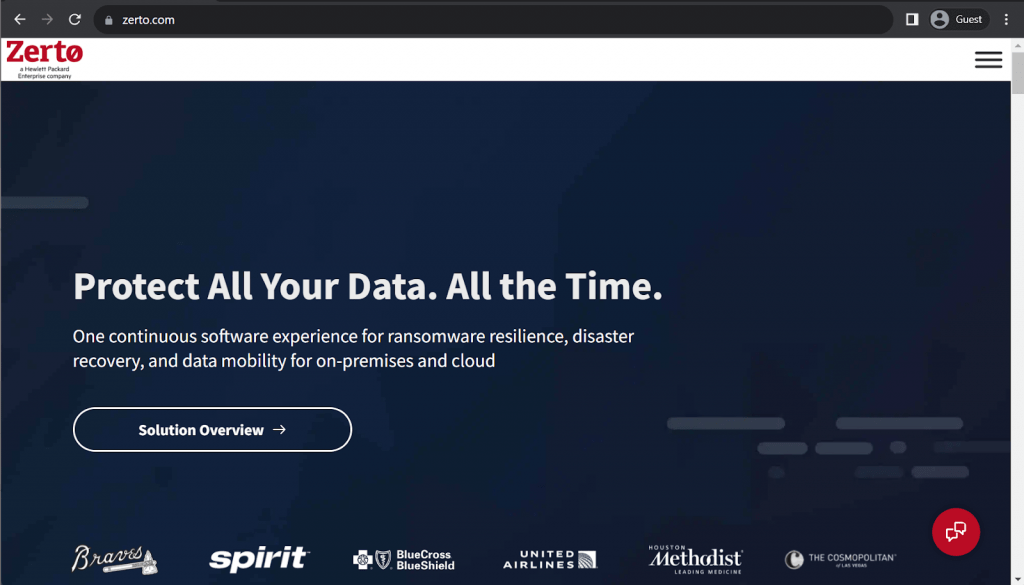
Zerto is a good choice in a multifunctional backup management platform with a variety of features. It offers everything a modern backup and restore solution should include: CDP (continuous data protection), minimal vendor lock-in, and more. It can be used with many different storage types, ensuring complete data coverage from the start.
Data protection has been one of Zerto’s core strategies from day one, allowing applications to be generated with protection from the start. Zerto also offers many automation capabilities, is capable of providing extensive insights, and can work with different types of cloud storage simultaneously.
Customer ratings:
- Capterra – 4.8/5 stars based on 25 customer reviews
- TrustRadius – 8.3/10 stars based on 122 customer reviews
- G2 – 4.6/5 stars based on 73 customer reviews
Advantages:
- Management simplicity for disaster recovery tasks
- Ease of integration with existing infrastructures, both on-premises and in the cloud
- Workload migration capabilities and many other features
Shortcomings:
- Can be deployed only on Windows operating systems
- Reporting features are somewhat rigid
- Can be rather expensive for large enterprises and businesses
Pricing:
- The official Zerto website offers three different licensing categories: Zerto for VMs and Zerto for SaaS
- Zerto for VMs includes:
- “Enterprise Cloud Edition” as a multi-cloud mobility, disaster recovery, and ransomware resilience solution
- “Migration License” as a dedicated license for data center refreshes, infrastructure modernization, and cloud migration
- Zerto for SaaS, on the other hand, is a single solution that can cover M365, Salesforce, Google Workspace, Zendesk, and more
- There is no official pricing information available for Zerto’s solution, meaning it can be acquired only via obtaining a personalized quote or purchased through one of Zerto’s sales partners
Customer reviews (original spelling):
- Rick D. – Capterra – “Zerto software and their amazing support team have allowed my company to bring in tens of thousands of dollars in new revenue by making it easy to migrate clients from Hyper-V or VMware to our VMware infrastructure.”
- AMAR M. – Capterra – “It’s a great software for any large organization. We use it both as a backup utility and DR site. Both sites work flawlessly without any issues. Support is a little hard to get but they are quite fast at responding, just not with the correct tech.”
My personal opinion on Zerto:
Zerto is an interesting option for large backup and recovery workloads. As a dedicated backup management platform, it was purpose-built to handle such tasks. Zerto’s main solution offers ransomware resilience, data mobility, and disaster recovery in a single package, while also being capable of working with a variety of different storage options. It is a Windows-exclusive solution, and the price tag tends to scale up quite fast for large companies, but the ability to perform workload migrations and integrate with different systems is usually worth far more than its cost for large companies. Security and scalability may be a significant concern for larger organizations, however.
Barracuda
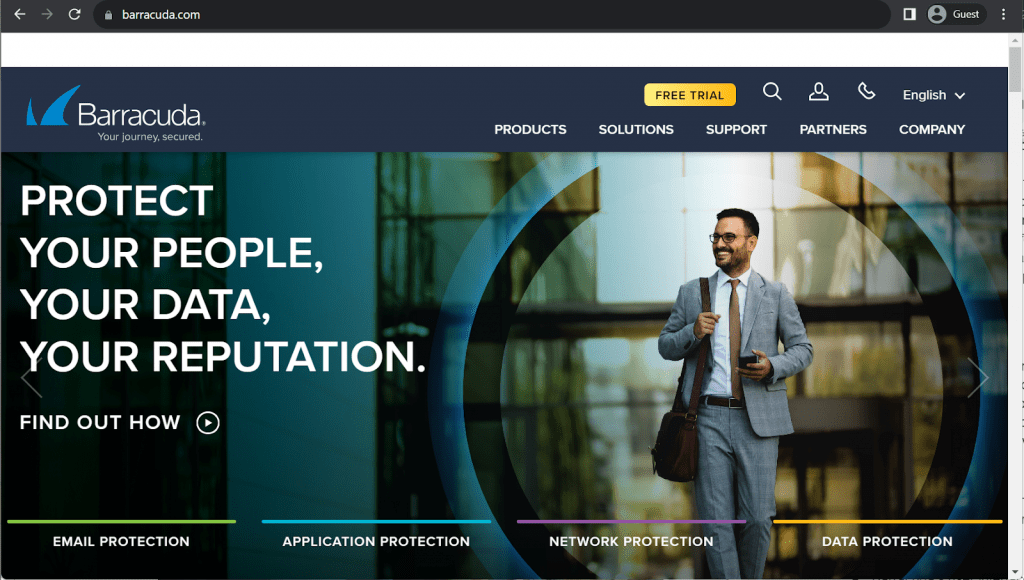
Barracuda is a fairly unusual company, in that it offers configurable multifunctional backup appliances as its approach to providing backup and recovery features. Barracuda Backup can create backups of applications, emails, and regular data. It offers extensive deduplication, data encryption, centralized data management, and many other backup and recovery features.
Customer ratings:
- TrustRadius – 7.6/10 stars based on 103 customer reviews
- G2 – 4.4/5 stars based on 52 customer reviews
Advantages:
- Barracuda’s user interface is relatively simple and easy to navigate, and creating backup jobs is intuitive
- Separate schedules can be set up for every single source that is backed up by Barracuda Backup’s appliance
- Data retention is also completely customizable and can be customized separately for every backup source
Shortcomings:
- Barracuda’s pricing policy is not egregious, but it is high enough to make it unaffordable for many smaller businesses
- The solution’s reporting capabilities are rather basic; filtering through multiple reports can be a bit of a problem
- Every first-time loading of the solution takes time, no matter how fast the connection or the hardware in question actually is.
- Lacks Kubernetes support
- Disaster Recovery has some strict limitations
Pricing (at time of writing):
- There is no specific public pricing available for Barracuda Backup, the only way to learn this particular information is to request a personalized quote.
- The way Barracuda collects data for such a quote is rather interesting. There is an entire configuration tool available that allows potential customers to choose from a number of options that allows Barracuda to gain a better understanding of the client’s needs.
- This configuration tool puts the user through five different steps before dropping the user to the last page with the request to “contact Barracuda to proceed,” including:
- Physical Locations – offers the ability to show how many different locations the user wants to cover, as well as the amount of raw data necessary (the basic setting is 1 location and 3TB of data)
- Deployment – the ability to choose among three different deployment options: physical appliance, virtual appliance, and managed service
- Offsite Replication – an optional feature that replicates data somewhere as offsite storage: Barracuda’s own cloud, AWS, network transfer to another physical location, or no replication at all (this particular option is not recommended)
- Office 365 Backup – this is a short and simple choice between choosing to create backups of existing Office 365 data or to decline the option if this is not to be backed up, or there is no data at all
- Support Options – a choice among three possible options, including the basic update package and 8-to-5 customer support; an option with instant equipment replacement in case of a hardware failure and the 24/7 customer support; and a separate option for a dedicated team of engineers to be assigned to your specific company’s case
Customer reviews (original spelling):
- Amanda Wiens – TrustRadius – “With the Barracuda Backup tool, we have all unified and centralized management. And regardless of location, we have a single console for managing cloud and simplifying everything. In our scenario, it is a large environment, and we recommend using a virtual infrastructure with a great fiber link. Backups and restoration are speedy and secure. It is undoubtedly the best solution in this field.”
- Josh McClelland – TrustRadius – “For larger environments, with virtual infrastructure in place, and the network bandwidth to support it, a Barracuda backup is great. It’s easy to back up an entire cluster, or just a single server. When it comes to restoring or spinning up a downed machine, the Barracuda Backup is second to none in these sort of environments. For the smaller clients, with budget concerns, only a few servers, not having the ability to spin up a failed server on the backup appliance itself is a little painful since we’d have to replace the physical hardware before getting services back online. I think having this ability would make for a great selling point to those smaller to medium size businesses that could benefit from this product.”
My personal opinion on Barracuda Backup:
Barracuda Backup is an interesting take on a hardware-based backup solution, using hardware appliances to provide data backups, email backups, application backups, and more. Its interface is easy to work with, and the solution also offers a significant amount of customization at different levels of the backup process. Also, Barracuda Backup has a rather basic reporting feature set. Because the solution relies more on hardware than solely on software, the solution price is that much higher, which could be too much for smaller or middle-sized businesses; a factor that is not as important for large-scale enterprises that can afford higher costs if it means complete data protection for their information. Overall, though, there have been significant questions about its tech support and its scheduling manager and user interface.
Arcserve UDP
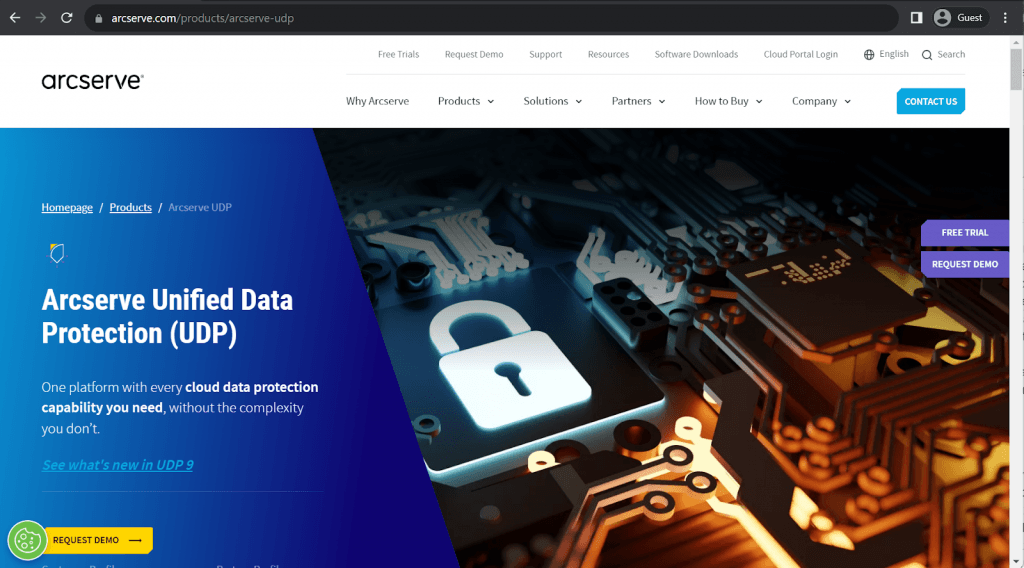
As a software provider, Arcserve is quite an interesting company with a variety of different solutions. Its flagship solution, Arcserve UDP, is also quite interesting in itself. It is a rather sophisticated cloud data protection solution that offers a variety of very specific high-end features usually seen only in an IT-grade environment. It can perform backups and restores in highly distributed environments, replicate virtual infrastructures, perform disaster recovery operations, and so much more.
However, the complexity of this solution is a double-edged sword of sorts, with the feature set itself being a hard sell for most SMBs and no public pricing available whatsoever.
Customer ratings:
- G2 – 4.3/5 stars based on 16 customer reviews
Advantages:
- As a cloud solution, Arcserve Cloud Direct need not be physically attached to a company’s server using some form of hardware appliance. It can provide cloud-native backup and recovery options after virtual deployment.
- Arcserve has many different software and solutions to choose from, and Cloud Direct specifically boasts a surprisingly long list of IT-grade data protection capabilities, including disaster recovery, backup operations, restore tasks, and more.
- Despite boasting a large variety of complex features and capabilities, Arcserve is surprisingly easy to work with and should be easy for practically any IT specialist out there to work with.
Shortcomings:
- Arcserve’s lack of support for any kind of mobile device may be a dealbreaker for some potential customers, simply because of the vast number of mobile devices being used inside of the single company on a regular basis
- There is no public information about the pricing of Arcserve’s cloud solution, but the variety of different expert-level features make it likely that this particular offering would not be suitable for smaller businesses whatsoever, and the lack of any kind of approximate pricing may turn even some larger clients away
- Arcserve Cloud Direct may be a cloud-centric solution, but the fact that it does not have any form of data deduplication to reduce storage requirements is not a a competitive position.
- Some of Arcserve’s tools and offerings are not as tightly integrated as they perhaps should be, causing difficulties for their users.
- Dedicated and specialized infrastructure may be needed
Pricing:
- Arcserve does not usually reveal any kind of pricing information about its solutions publicly. As such, the only way to receive such information for a company is for the company to request a personalized quote.
Customer reviews (original spelling):
- Robert G. – G2 – “Cloud Direct is an excellent option for easy and secure off site backups and data storage. Product works great and as long as you have good internet, it has minimal impact on network performance. Cost effective and easy to use. MSP rich features and one console for all customer control makes this product a very useful and profitable software offering in our stack of services. Retention policy is built off calendar days and not backup generation count. So if you have a 7 day retention and you skip Sat and Sun on your backup schedule, then you only have 5 generations as the other 2 days count and will delete your generations.”
- Peter M. – G2 – “Setup is a breeze. Support is very responsive. The interface isn’t exactly intuitive. They tried to make it super intuitive, but in the process, it’s hard to know if you’re doing the right things for actually backing all your drives or setting up for disaster recovery.”
My personal opinion on Arcserve:
Arcserve as a software provider is the most popular company in this market,nor is it completely unknown, either. Arcserve offers a variety of different solutions and software to choose from, one of which being its UDP solution: a comprehensive cloud-oriented data protection platform with many features usually found only in very complex enterprise-level backup software. Unfortunately, this level of complexity is also one of the biggest detriments to Arcserve’s popularity, leading to both small and large companies not picking it for one reason or another. Nevertheless, it still has an audience, and it can work for middle-sized IT teams that are knowledgeable. There are also reports that it can be consume significant amounts of network bandwidth and needs specialized equipment.
Enterprise backup software comparison
The amount of information presented above can be somewhat overwhelming at first, especially when comparing specific solutions with one another. To try and mitigate that issue, what follows is a comparison table of all the software reviewed here, using several different parameters:
- Deduplication support.
- Container (OpenStack, Docker, etc.) support.
- Mobile app support.
- CDP (Continuous Data Protection) support.
- Immutable backup support.
These specific solutions were chosen for this comparison for several reason. Most of these backup solutions are well-known and respected in the enterprise software field, making it difficult to find basic features and functions that some solutions might not have. For example, parameters such as cloud support, disaster recovery, and data encryption were excluded only because every single solution on the list already has these – completely invalidating the whole point of comparing software with one another.
As such, there are five different parameters that can actually be compared across multiple software examples.
| Software | Deduplication | Container Support | Bare Metal Recovery | CDP Support | Immutable Backups |
| Rubrik | Yes | Yes | Yes | Yes | Yes |
| Unitrends | Yes | No | Yes | Yes | Yes |
| Veeam | Yes | Yes | Yes | Yes | Yes |
| Commvault | Yes | Yes | Yes | Yes | Yes |
| Acronis | Yes | Yes | Yes | Yes | Yes |
| Cohesity | Yes | Yes | Yes | Yes | Yes |
| MSP360 | No | No | Yes | No | No |
| IBM Spectrum | Yes | Yes | Yes | Yes | Yes |
| Dell Data Protection Suite | Yes | Yes | Yes | No | Yes |
| Vembu | Yes | No | No | Yes | Yes |
This table is also separated into two halves to simplify its navigation for the end user.
| Software | Deduplication | Container Support | Bare Metal Recovery | CDP Support | Immutable Backups |
| Veritas | Yes | Yes | Yes | Yes | Yes |
| NAKIVO | Yes | No | No | Yes | Yes |
| NetApp SnapCenter | No | Yes | No | No | No |
| Bacula Enterprise | Yes | Yes | Yes | Yes | Yes |
| Asigra | Yes | No | No | No | Yes |
| Carbonite | No | No | No | No | No |
| Druva | Yes | Yes | No | Yes | Yes |
| Zerto | No | Yes | No | Yes | Yes |
| Barracuda | Yes | No | No | No | No |
| Arcserve | Yes | No | No | No | Yes |
It should be noted that all software is being improved and expanded on a regular basis, which is why it is wise to double-check the software’s capabilities before choosing one of these options.
How to choose an enterprise backup solution?
Picking a single backup solution from a long list of competitors can be extremely difficult, due to the many factors to be considered. Make the process easier, use a checklist like the one below.
- Figure out a backup strategy
A detailed backup strategy is practically required for large-scale businesses and enterprises, making it easier to plan ahead and decide the appropriate action for specific situations – user errors, system failures, cyberattacks, etc.
Some of the most common topics that should be addressed in a backup strategy are:
- High availability. Different companies have different preferences among backup storage locations, whether cloud storage or on-premises storage within its infrastructure. Determining where to store future backups is an essential first step. In the context of the 3-2-1 rule, there should be several locations, both on- and offsite.
Examples of high availability infrastructure for enterprises:
Two backup servers: the primary in the main data center, while the second one in another data center or in the cloud. A combination of storage systems following the 3-2-1 rule: on-premises NAS or SAN via RAID, cloud and tape for resiliency. Real-time block-level replication between both servers. Automated failover and load balancers for backup servers to minimize load. High-performance network switches and paths, fibre channels. All of the above with a monitoring system and automated alerts.
- Backup scheduling. Understanding the best time to perform a system backup is key to ensuring that there are no interruptions or slow-downs in regular operations due to a sudden backup process. Many backup solutions prefer to create full backups outside of business hours to avoid interruptions to the business itself. However, enterprises may have so much data that creating full backups takes even longer than night backups. In such situations synthetic full backups may be a better option.
Example of a backup schedule for an enterprise:
Create full backups during weekends (for example, Sunday midnight) to minimize their impact on applications’ performance. Perform incremental backups at the end of each workday (for example, 11:30 PM Monday to Saturday). A single differential backup on Wednesday night. Of course, for systems with critical importance (high-transactional DBs, for example) execute more frequent incremental backups, probably several times per day.
| Day of Week | Backup Policy | Explanation |
| Sunday | Full | Complete snapshot of all data |
| Monday | Incremental | Capture changes since Saturday |
| Tuesday | Incremental | Capture changes since Saturday |
| Wednesday | Differential | Capture all changes since last full backup |
| Thursday | Incremental | Capture changes since Saturday |
| Friday | Incremental | Capture changes since Saturday |
| Saturday | – | No scheduled backups, preparation for full backup |
| Last Sunday of the Month | Full + Offsite Storage | Comprehensive monthly backup with redundancy (cloud archive or tape) |
- Backup policies. Determining backup policies wisely allows for adequate storage space and network bandwidth. A full backup would be best performed at regular intervals, (once a week or a month, depending on the situation), and an incremental backup on a regular basis (daily, for example) to ensure data consistency. Differential backups require more storage space than incremental backups, but are faster to restore. The proper mix of backup policies depends on data size, data type, data change frequency, RTO & RPO, and network and storage resources.
Example of an enterprise backup policy:
Perform a full backup once a month, during the weekend when the network usage is at a minimum. Add 2-4 differential backups during the month to track changes since the last full backup. In addition, add daily incremental backups to track day-to-day differences. Once a month, use all incremental backups to create a synthetic full backup, in case a new full backup is not possible.
- Backup targets. An average company may have multiple storage types as part of its infrastructure. The main goal is determining the specific storage types needed for a backup solution, while also keeping the potential backup size in mind (since backups tend to grow in size as time goes on, and knowing when it is time to expand the existing storage or purchasea new type of storage is important). Implementing tiered storage is also a good tactic, when essential datasets are stored in more expensive storage with rapid recovery capabilities, while older or less critical datasets may be placed into slower cloud storage, like Amazon Deep Archive or tape media.
- Audit requirements. There can be many industry-specific requirements and standards for data storage to which the company must adhere . Having a complete understanding of the regulations governing the company is a great advantage in choosing a backup solution. For example, organizations almost certainly must comply with GDPR and CCPA, PCI DSS when accepting online payments; HIPAA for medical organizations, SOX for publicly traded companies, CMMC for companies working with US DoD, and others.
- RTOs and RPOs. These parameters are some of the most important for any backup strategy. As their names suggest, RTO represents the length of time to restoration of the company’s operational status. Conversely, RPO represents the acceptable level of data loss. Understanding the company’s RPO and RTO makes deciding the parameters of the backup strategy, such as recoverability, backup frequency, recovery feature set, and backup software SLAs, much easier.
Example of RTO & RPO requirements for an enterprise:
- Critical apps & high-transactional databases
- 1-2 hours RTO, 10 minutes RPO
- Regular work apps (CRM, ERP, etc)
- 4-6 hours RTO, RPO 1 hour
- Email, messenger and other communication apps
- 2-4 hours RTO, 30 minutes RPO
- File shares
- 24 hours RTO, 4 hours RPO
- Other non-critical and demo systems
- RTO 24-72 hours, 12-24 hours RPO
The process of finalizing the backup strategy as a single document must be a collaboration among multiple departments, to ensure the strategy’s adherence to the company’s objectives and business goals. Creating a concrete backup strategy is an excellent first step toward understanding what the company needs from an enterprise backup solution.
- Research backup solutions for enterprises
This entire step requires collecting information about backup solutions. This article has already done so, by assembling a long and detailed list of enterprise backup software tools. Of course, the analysis can go much deeper by calculating business-critical parameters and comparing different features based on the results of specific tests.
- Calculate the Total Cost to Operate of each solution being considered
Enterprise backup solutions are considered long-term investments, and performing a cost-benefit analysis and calculation. TCO makes it much easier to evaluate the software. TCO of each solution being considered should include:
- Cost of the license (perpetual or subscription-based model);
- Cost of the hardware;
- Implementation fees (if you planning to outsource integration);
- Cost of ongoing support and updates;
- Cost of power, cooling and other utilities to run the backup system;
- Cost of additional bandwidth and network;
- Cost of storage (disks, tape, cloud, as well as storage management software costs);
- Cost of training personnel.
- Perform “Proof-of-Concept” (PoC) tests
Once the field of potential backup solutions has been narrowed down to a relatively small list, it is time to move on to the testing phase to ensure that the solution meets the company’s designated objectives. This is also where a more detailed evaluation of features should be done. The idea is to ensure that the more essential capabilities are included in the backup solution, to avoid trading “easy data recovery” for “easy first-time setup.” A good PoC should work within the existing IT environment and not on a demo stand, to make sure the system behaves as expected when moved into production. The testing itself involves both feature testing and stress testing the whole system under a significant load. Also test the vendor’s support team, its responsiveness and effectiveness, and its documentation. To succeed, clearly define objectives and success metrics, and set a realistic timeline for all tests to ensure that the PoC is time-efficient.
- Finalize your choice & update DR procedures
At this point, there should be little or no doubt about choosing an enterprise backup solution. Creating disaster recovery and business continuity plans around the new backup solution and its capabilities is essential. This is the final step of the process – ensuring that there is a detailed rulebook that specifies what actions are taken to protect each and every part of the system and what needs to be done if the system suffers some sort of data breach.
Who are the most frequent user of enterprise backup solutions?
- Government and military organizations. Both military and government organizations work with information just as much as any other commercial company, if not more often. However, the requirements for data security and backup capabilities in these cases are much stricter and more extensive, meaning that most backup solutions could not operate within these boundaries without completely changing their entire backup process. As a result, these organizations require true enterprise-grade solutions for backup.
- HPC data centers. HPC data centers are created to analyze large data masses for analytical or AI-oriented purposes, and these large data masses are stored in large-scale, high-transactional databases for further analysis or processing. However, not every backup solution can protect massive volumes of data – and in addition, this information must be as secure as every other data type. Enterprise backup software is the only obvious choice for such organizations, but beware: there are barely a handful of solutions that can meet the typical needs of a true HPC environment.
- Research organizations. Many organizations in the R&D field are regularly generating massive amounts of data amounts. The data in question is necessary for various processes, and protecting such data is paramount for any organization. The data in question can include datasets for analysis, data for complex simulations, personal medical information, experiment results, etc. Many of these organizations are running IT environments that are approaching HPC specifications.
- Fintech field. Many financial tech businesses must interact with massive data volumes regularly, be they banks, investment firms, insurance businesses, etc. Much of this involves processing data in real time. Extensive data protection solutions are necessary to protect this data while remaining compliant with PCI, DSS, SOX, and other regulations.
- Healthcare field. The healthcare field has an entirely separate field of work with its own set of regulations regarding sensitive data storage. Businesses dealing with protected health information (PHI) must comply with regulatory frameworks such as HIPAA. Introducing an enterprise backup solution in this sphere is nearly always necessary to correctly protect its data, ensuring fast data recovery in case of a disaster, and providing data continuity in a very demanding industry.
- E-commerce and retail. Customer data that retailers collect regularly involves many different types of information, from transaction records and payment data to inventory information and so on. Much of this data is subject to one or several regulatory frameworks. Enterprise backup solutions exist to protect and safeguard information like this, combining compliance with protection in a single package.
- Universities and Education. Universities and other educational organizations typically produce and store significant volumes of data, whether student data, administrative personnel data, research data, orscience projects. The sheer amount of data involved typically means the educational sector must employ enterprise-level backup solutions to mitigate risks and to manage and protect its data.
The future of enterprise backup and recovery
The entire enterprise-grade backup and recovery industry has been undergoing a metamorphosis of sorts as it adapts to new situations. The average IT environment is far more complex and data-rich than ever before, and legacy data protection methods are increasingly struggling to protect large volumes of complex information.
Enterprise backup solutions must now adopt a proactive approach, moving far beyond simply reacting to existing issues to preventing potential problems before they arise. The ability to monitor sensitive data continuously is far more resource-demanding than regular data protection methods. Still, it also provides better protection, less downtime, and fewer chances of data loss.
Implementation of ML and AI features are also increasing in this industry, elevating the potential of existing tools to new levels of task optimization and process automation. The same can be said of application-aware backups, granular recovery, higher security, and many other relatively new industry requirements.
There is much greater emphasis on data security than ever before. As data breaches become more common, features such as access control, encryption, and immutability are virtually mandatory for any enterprise-grade backup solution. Unfortunately, this trend is certain to continue. The best enterprise backup solutions work constantly to stay ahead of constantly developing data breach methods and approaches by threat actors.
The future of the industry as a whole is moving towards backup solutions that are faster, more secure and, at the same time, more versatile. Expanding on new advancements and functions in the field is how modern enterprises can ensure the safety of their information at all times.
The impact of enterprise backup solutions on environmental sustainability
Enterprise backup solutions strive to earn customer success, trust, be innovative, and so on. There are other, less-known values, although they receive far less recognition in comparison. Sustainability is an example of such a key value, even if it is as important as the rest. The idea of sustainability as a key value of a backup solution implies that different stakeholders hold long-term values along social, ethical, economic, and cultural dimensions.
Environmental concerns have been at the top of global discussion in many different industries and specialty fields. The importance of the environment and sustainability is at its highest now. It would be wrong to assume that an industry as software-defined as backup solution software cannot contribute to this in any way. On the contrary, solutions such as Bacula Enterprise can offer many different examples of how they attempt to reduce the environmental impact of their work while also promoting sustainability.
Bacula utilizes a variety of different green practices to reduce the overall environmental impact of its work, including both energy consumption and carbon footprint. The computing resources of the software are optimized to reduce energy consumption, and server virtualization reduces the requirement in terms of physical servers, resulting in a smaller carbon footprint and energy reduction once again.
Bacula’s software supports and extends the hardware’s lifespan as much as possible, while utilizing available resources with maximum efficiency. The inherent customization allows for only necessary functions to be used regularly, resulting in generally better user experience and the ability to adapt to various sustainability goals from many sectors and industries.
Conclusion
The enterprise backup solution market is vast and highly competitive, which is both a positive and a negative factor for all customers. The positive factor is that competition is at an all-time high as companies strive to implement new features and improve existing ones to stay ahead of their competitors, offering their customers an experience that is constantly evolving and improving.
On the other hand, the wealth of options makes it extremely difficult for any company to choose one single solution. The many different factors that go into choosing an enterprise backup solution, not to mention the cost of making the wrong choice make the process of choosing extremely difficult.
This article has present a long list of different enterprise backup solutions with all of their unique features, positive and negative sides, user reviews, etc. An enterprise-grade backup solution is a sophisticated combination of features and frameworks with the goal of providing a multitude of advantages to end users in large-scale enterprises.
An enterprise-level backup solution consists of many different elements, including flexibility, mobility, security, feature variety, among many others. Choosing the appropriate backup solution for a specific company is a long and arduous process that can be made somewhat less complicated by using the sequence of steps presented in this article. As for the specific solution recommendations, our list included a variety of interesting examples of enterprise backup software suitable for all kinds of clientele.
Commvault might be an option for a large enterprise that is wiling to pay more for one of the best feature sets on the market. Acronis Cyber Backup is a great choice for larger companies that are dealing with a lot of sensitive data, as it can offer one of the most sophisticated data security feature sets on the market. Veeam is another highly regarded player in the enterprise backup and disaster recovery market, known for its robust solutions that cater to a wide range of environments, including premium capabilities in virtual environments.
Alternatively, there are also backup solutions, such as Bacula Enterprise, that offer exceptionally high security, flexibility and scalability. Bacula Enterprise offers coverage to companies with many different storage types in place – from physical drives to virtual machines, databases, containers and clusters, with up to 10,000 endpoints covered at the same time. It also excels in scalability to the point where it is favored by HPC and super computer users.
Bacula works with both enterprise-grade commercial infrastructures and government entities. The Warner Bros. Discovery conglomerate uses Bacula Enterprise for its live media broadcast environment, reporting exceptional results with a reasonable price tag and impressive customer support. Additionally, Bacula is well-known for its strong ability to ensure organizations meet compliance needs.
One of the most unconventional examples of Bacula Enterprise’s versatility is the fact that NASA chose Bacula’s solution. The next quote belongs to Gustaf J. Barkstrom, Systems Administrator at SSAI, NASA Langley contractor.
«Of those evaluated, Bacula Enterprise was the only product that worked with HPSS out -of-the-box without vendor development, provided multi-user access (BWeb), had encryption compliant with Federal Information Processing Standards, did not have a capacity-based licensing model, and was available within budget»
All in all, figuring out a specific solution for your company is no easy task, and we hope that this article was helpful to you in providing as much information about a number of different offerings as possible.
Why you can trust us
Bacula Systems is all about accuracy and consistency. Our reviews always try to provide the most objective point of view on different technologies, products, and companies. Our reviews use many different methods, such as product info and expert insights, to generate the most informative content possible.
Our materials describe many factors about every single solution presented, be it feature sets, pricing, customer reviews, etc. Bacula’s product strategy is overseen and controlled by Jorge Gea, the CTO of Bacula Systems, and Rob Morrison, the Marketing Director of Bacula Systems.
Before joining Bacula Systems, Jorge was for many years the CTO of Whitebearsolutions SL, where he led the Backup and Storage area and the WBSAirback solution. Jorge now provides leadership and guidance in current technological trends, technical skills, processes, methodologies and tools for the rapid and exciting development of Bacula products. Responsible for the product roadmap, Jorge is actively involved in the architecture, engineering and development process of Bacula components. Jorge holds a bachelor’s degree in computer science engineering from the University of Alicante, a Doctorate in computation technologies, and a Master’s Degree in network administration.
Rob began his IT marketing career with Silicon Graphics in Switzerland, performing strongly in various marketing management roles for almost 10 years. Rob then spent 10 years in various marketing management positions in JBoss, Red Hat, and Pentaho, ensuring market share growth for these well-known companies. He is a graduate of Plymouth University and holds an Honours degree in Digital Media and Communications.
Frequently Asked Questions
What are the biggest differences between enterprise-grade and consumer-grade backup tools?
Enterprise backup solutions are primarily designed with large-scale environments in mind, providing advanced features like encryption, deduplication, support for hybrid infrastructures, and more. Consumer-grade tools, on the other hand, primarily use basic file backup and recovery methods without most of the substantial features in automation, security, and scalability that most enterprise tools have.
How can immutability protect against ransomware attacks?
Backup immutability exists to ensure that information cannot be altered for a specific retention period once it has been written. This approach, often referred to as WORM (Write Once Read Many) offers substantial security against most ransomware attacks, preventing them from encrypting or otherwise modifying existing immutable data.
Why is air-gapped storage important in enterprise data security?
Air-gapped storage uses physical or logical isolation of backup data from the rest of the environment to prevent direct access to it from external sources – including cyber-attacks and ransomware. This isolation ensures the safety of backup data,even when the primary systems of the environment have been compromised.



